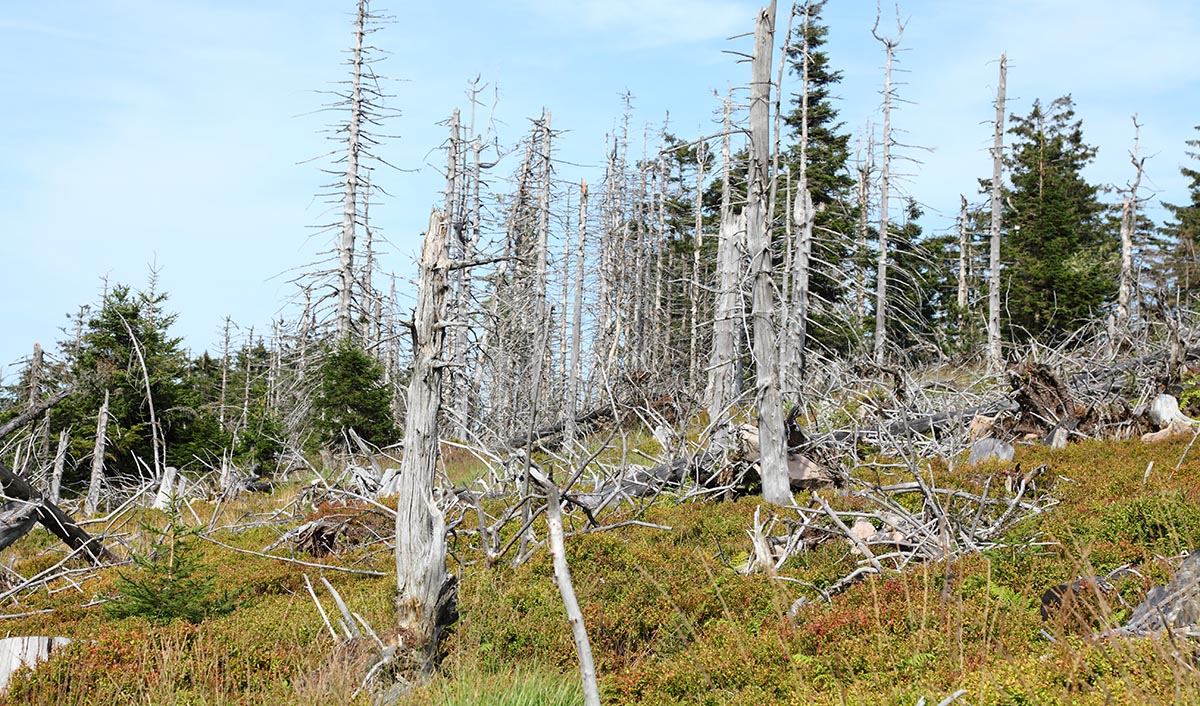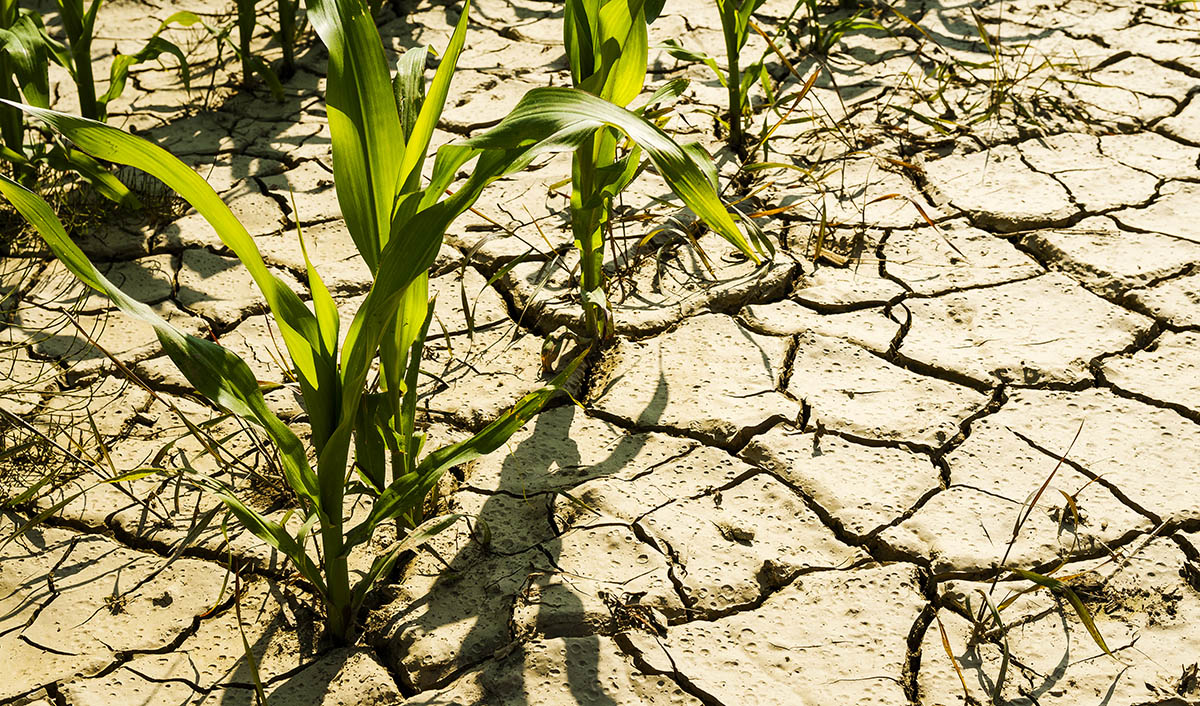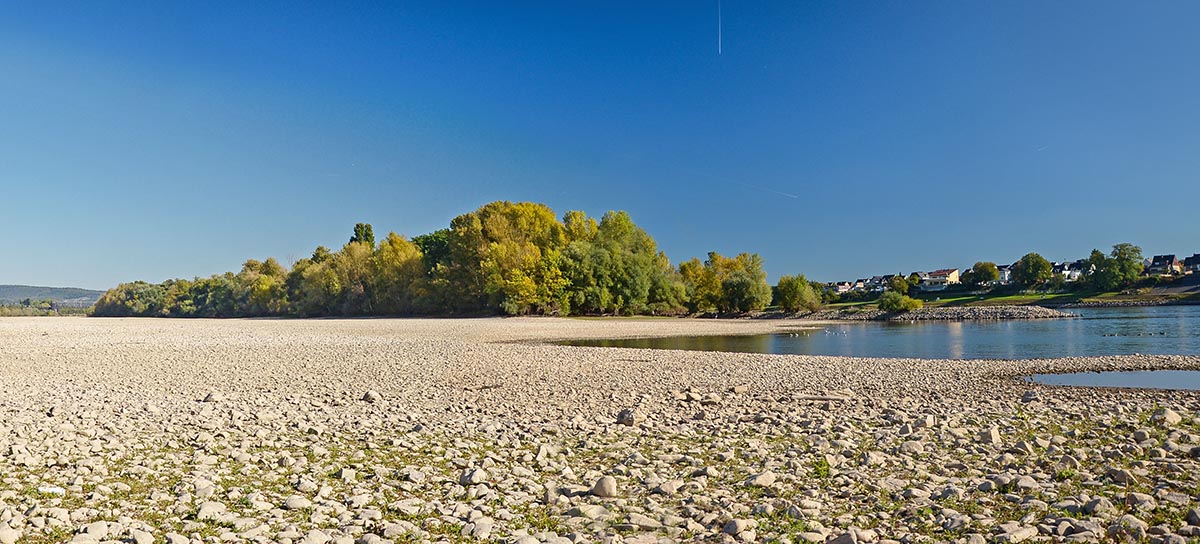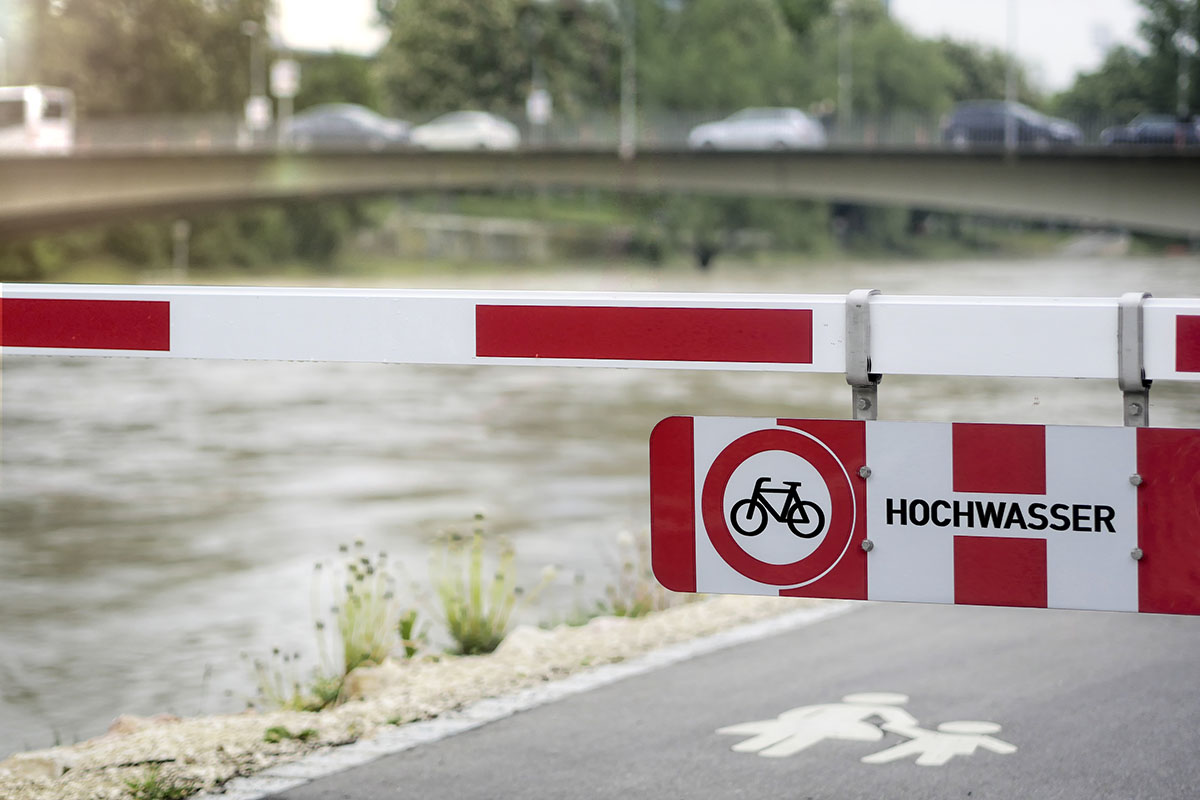The knowledge collection provides background information on the relevant areas of intervention and regional climate variables involved in adapting to the consequences of climate change in Baden-Württemberg. The information is primarily aimed at small and medium-sized municipalities and districts. Individual climate variables and courses of action can be queried via the collection, as can the effects of a variable on a specific area of action. The overview is based on current research on concrete impacts and measures, but does not claim to completeness.
In the further course of the project, the information will be continuously supplemented and updated. Since the effects of climate change vary greatly from region to region, the effects described do not apply to every municipality. The measures are listed as examples and need to be adapted to the situation and the local context on site.
If you have any information or practical examples that you would like to publish here, please send us a message via e-mail.
The heat stress parameter is composed of the indicators tropical nights, summer days and heat days. A tropical night is when the temperature does not fall below 20°C. A summer day is when the temperature is more than 25°C and a tropical day is when it gets warmer than 30°C in one day. Heat stress will increase in the coming decades due to climate change. In particular, a significant increase in tropical nights, summer days and heat days can be expected in the distant future.An increase in unusually warm days can lead to heat stress, putting strain on the human well-being.

Climate change has multiple impacts on human health. Thermal stress due to heat waves, increased UV radiation as well as extreme weather events and related accident hazards are directly attributable to climate change. Non-communicable diseases (such as cardiovascular diseases and allergies) may increase as well as infectious diseases due to food and drinking water hygiene problems.
Impacts
- Heat stress and heat stroke on the rise
- Particularly affected: People over 65, young children under 6, people with pre-existing conditions, the homeless, and outdoor workers
- Hyperthermia and dehydration due to decreased sense of thirst
- Cardiovascular system is affected (heart attacks)
- Sleep disturbances due to tropical nights occur more frequently
- Higher UV exposure and associated increased risk of sunburn, sunstroke and skin cancer
- Warmer climate makes it more difficult to ensure hygiene (e.g. cold chain for food in public facilities)
Initiatives
- Use of heat warning systems
- Use of social media and communication channels (warning apps, radio announcements) to warn and change behavior
- Development and implementation of heat action plans
- Preservation and creation of cold air and fresh air corridors
- Preservation and expansion of shaded open spaces
- Establishment of “climate comfort zones,” for example, freely accessible cool rooms
- Expansion of blue-green infrastructure
- Provision of mobile public drinking fountains in highly frequented areas
- Target-group-specific offer of psychosocial assistance in case of heat stress
- Establishment of permanently installed drinking water dispensers in public spaces
Of particular concern for urban and spatial planning is the increased heat load, flooding due to heavy rain and floods, and the increased drought. The strong warming of sealed inner-city areas (urban heat island effect) increases the thermal load in densely populated areas. Floods and heavy rainfall have a high damage potential and lead, among other things, to threats to critical infrastructure. Urban and spatial planning can promote climate-adapted planning in many ways and contribute to adaptation to the consequences of climate change with its control tools.
Impacts
- Temperatures in large cities are up to 10 degrees °C above those of the surrounding countryside (urban heat island effect)
- Demand for recreational areas (green and open spaces) increases
- Cold air production areas and fresh air corridors should be taken into account in land use plans
- Demands on social infrastructure change (e.g. air conditioning of kindergartens and gymnasiums)
- Particularly affected: densely built-up and highly sealed urban areas (such as city centers and commercial areas)
Initiatives
- Building blue-green infrastructure
- Use of light-colored pavements in streets and squares to reduce surface heating in cities
- Development of regenerative heat networks (with climate cooling in summer)
- Climate-oriented localization, orientation, positioning and zoning of construction areas and buildings to largely avoid wind and weather loads
- Alignment of buildings with structural cold and fresh air corridors
- Development of multifunctional green and open spaces
- Unsealing and keeping free cold air production areas
- Checking of redensification plans for climatic effects and negative influences on ecological diversity
- Planting of drought- and heat-resistant native trees
- Expansion or promotion of green roofs and facades on public and private buildings
- Establishment of urban climatic building restriction areas
- Permanent installation of water dispensers in pedestrian zones
Extreme storms, hail, heat and flooding can cause high damage to private and public buildings. Such extreme weather events may occur more frequently and be more severe due to climate change, increasing the risk of damage. Not all potential damage can be covered by insurance.
Impacts
- Indoor heat load increases
- Cooling demand in buildings increases
- Damage to building and building fabric due to thermal load increases
Initiatives
- Consideration of the urban climate in building design (e.g., orientation of buildings)
- Support and promotion of unsealing
- Construction measures: light facade color, insulation, window areas that are not too large, summer heat protection, roof and facade greening, ventilation options
- Shading of construction measures to protect construction site personnel
- Air conditioning with regenerative energies (for example via groundwater)
Impacts
- Groundwater levels drop, springs dry up
- Low water levels of surface waters
- Water demand increases in summer
- Drinking water quality decreases due to increased water temperatures
- Fish mortality due to lack of oxygen
Initiatives
- Formation of supra-local water supply systems
- Promotion of water-saving measures for private households, businesses and municipalities (through general calls to save water, withdrawal bans)
- Organization of irrigation management
- Restriction of cooling water consumption and discharge into natural waters
- Development of additional groundwater wells
- Securing public drinking water wells
Temperature and precipitation usually have a very direct impact on species and their habitats. Many species and habitats are already endangered in their populations and distribution. Climate change may exacerbate this development in the future. Due to climate change, plant and animal species either adapt, migrate or become extinct in their previous habitats. Some species also benefit from climate change because, for example, their habitat expands. Particularly negative consequences of climate change can already be observed today for species that are exclusively native to mountain regions and for species with a strong specialisation in very small-scale locations.
Impacts
- Biodiversity decreases
- Heat damage to plants increases
- Soil water content decreases
- Wetlands and bogs dry out
Initiatives
- Promotion of native species with high heat and drought tolerance
- Increased irrigation during hot spells, e.g. through the formation of tree sponsorships
- Reduction of heat stress for urban flora and fauna through unsealing and increasing the proportion of greenery
Agriculture is directly affected by the consequences of climate change. Continuous climatic changes as well as weather and weather extremes such as hail, floods, storms, drought and heat as well as early and late frosts influence cultivation conditions and production possibilities. Extreme events whose local occurrence cannot be precisely predicted are particularly problematic here. They can lead to considerable economic losses. Climate change also influences soil properties and can thus impair soil performance. Changing precipitation regimes can cause increases in water runoff and soil erosion, or increased soil compaction. Increasing temperatures may lead to a reduction of humus and a change in the diversity and activity of soil organisms.
Impacts
- Heat stress and drinking water demand for livestock increases
- Irrigation requirements for crops increase
- Crop losses and losses of heat-sensitive varieties increase
- Plants are damaged by heat, for example in fruit growing
- Dry cracks in the soil and soil crusting
- Soil structure changes
Initiatives
- Establishment of sustainable irrigation systems
- Use of mobile water tanks for pasture management
- Use of sustainable UV protection nets for special crops
- Application of humus-amplifying cultivation and management methods
- Promotion of preventive soil protection measures
- Promotion of knowledge exchange/exchange of experience between farms, responsible experts at district level and regions with comparable challenges
- Support for farmers in adapting livestock housing to higher thermal loads
Forests can make an important contribution to climate protection and at the same time have cooling effects on their surroundings during hot spells. However, the consequences of climate change, especially increasingly frequent and prolonged dry and hot phases, are putting a strain on forests and posing challenges for forest owners and forest managers. Forests are not only threatened by increasingly frequent fires. The trees weakened by drought are also less resistant to strong wind events or pests, such as the bark beetle.
Impacts
- Growth performance is reduced due to heat stress
- Susceptibility to pests (e.g. bark beetles) increases
- Heat-sensitive tree species die
Initiatives
- Conversion to a near-natural mixed forest
- Comprehensive forest ecosystem management (also with regard to forest fire)
- Raising public awareness
- Financing and equipping the volunteer fire brigades
Climate change also has an impact on the energy industry. A general rise in temperature may on the one hand reduce the demand for heating energy in the winter months, while on the other hand increase the demand for cooling energy during increasingly warmer summer months. Extreme weather events such as storms, droughts, low and high water can affect the operation of energy supply plants and facilities. An example of this is the dependence of thermal power plants on the availability of sufficient cooling water for electricity generation, which is usually taken from rivers. During summer low water levels, there are increasingly frequent restrictions on power plant operations.
Impacts
- Electricity consumption for cooling energy demand in summer increases
- Lack of cooling water in power production leads to curtailment of production
- Electricity demand for water treatment increases
- Heat strains the energy infrastructure
- Technical equipment is damaged or fails due to overheating
- Yields in biomass production decrease
- Efficiency of solar plants deteriorates
Initiatives
- Expansion of renewable energies and energy storage systems as well as their associated infrastructure (diversification, balancing options)
- Cooling of technical equipment and appliances
- Raising public awareness on energy conservation
Climate change can bring both risks and opportunities for the economy. The direct and indirect impacts of climate change are extremely diverse and depend on the size, location, structure and sector. Both direct location-related risks (e.g. operating facilities damaged by extreme weather) and cascading effects, for example problems in the supply chains due to blocked transport routes or extreme events with negative impacts at foreign production locations, must be identified.
Impacts
- Cooling requirements of buildings and equipment increase
- Performance of employees is reduced
- Supply chains are burdened (heat stress on transport infrastructure due to melting asphalt, reduced transport capacities due to low water for shipping)
Initiatives
- Systematic, forward-looking risk management
- Shifting working and production times in the morning/evening (especially for heat-intensive production)
- Diversification of suppliers
- Insurance against natural hazards
- Identification of critical supply components
- Provision of drinking water
- Structural preventive measures
Extreme weather events are increasingly causing disruptions to traffic on roads, railways, in the water and in the air. Landslides and undercutting, but also extreme heat, can lead to the destabilisation and destruction of roads, footpaths and sections of railway lines. Storms can directly cause obstructions or damage roads, tracks and power lines via windthrow. Extreme events also change the demand for different modes of transport, for example when pedestrians and cyclists switch to cars or public transport due to high heat.
Impacts
- Traffic infrastructure can only be used to a limited extent due to heat stress (blowups, ruts, track systems, failure of air conditioning systems)
- Risk of accidents increases due to reduced ability to concentrate
- Costs for repairs and maintenance increase
- Demands on transport services change (e.g. air conditioning)
- Fires on embankments increase
Initiatiives
- Air conditioning in local public transport
- Temporary speed limits or driving bans to prevent damage to road surfaces, driving bans if necessary
- Shading of road spaces/ parking lots/ bus stops by trees
- Construction of roads with lighter surfaces to reduce surface heating
For tourism, climate change brings both opportunities and risks. In the medium to long term, winter sports locations in Germany are likely to lose out, as snow reliability in the low mountain ranges will decline as the climate warms. Summer tourism, on the other hand, could benefit from climate change: through a shift in tourism flows from the currently popular Mediterranean regions and an extended season with warmer and drier weather for swimming, camping and hiking holidays.
Impacts
- Heat impacts many types of tourism, especially outdoor activities and medical and spa tourism
- Demand for water-related activities increases
- Heat stress in urban areas increases (impact on city tourism)
- Pressure on local recreation areas increases
- Specific short-term demand can have a positive impact (ice cream parlors, swimming pools, beer gardens)
- Water-related local recreation areas are overloaded (e.g. swimming pools)
- Bathing and drinking water quality impaired
- Forest fires can endanger the safety of tourists
Initiatives
- Heat plans with specific references to shaded areas, rest rooms, water dispensers
- Freely accessible air-conditioned indoor spaces (museums, shopping malls)
- Adaptation of visitor management in water-related areas
- Periodic opening of cool spaces during hot spells
- Development of outdoor-independent tourism alternatives
The effects of climate change must also be taken into account in the area of civil protection. The focus here is on efforts to optimise or expand existing structures in emergency and rescue services as well as disaster management. The aim here is not only to react quickly and effectively in the event of extreme weather events (heat waves, floods, inundations, heavy rainfall events, storms) but also to prepare for disasters against the background of changing climatic conditions. The focus here is on both population protection and the protection of critical infrastructures.
Impacts
- Indoor spaces heat up strongly and lead to acute health hazards (e.g. in childcare and elderly care facilities)
- Heat injuries to people working outdoors increase
- Frequency of operations increases
- Expenditure on technical equipment (vehicles, materials, batteries) increases
Initiatives
- Use of social media and communication channels (warning apps, radio announcements) to warn and change behaviour
- Development of emergency plans and drills
- Equipping with heat-adapted technical and medical aids
- Identification and protection of critical infrastructure
- Preventive measures (spraying down, distributing drinking water)
Extreme weather events are increasingly causing disruptions to traffic on roads, railways, in the water and in the air. Landslides and undercutting, but also extreme heat, can lead to the destabilisation and destruction of roads, footpaths and sections of railway lines. Storms can directly cause obstructions or damage roads, tracks and power lines via windthrow. Extreme events also change the demand for different modes of transport, for example when pedestrians and cyclists switch to cars or public transport due to high heat.
Impacts
- Maintenance requirements for roadside greenery to maintain road safety are increasing
Initiatives
- Adaptation of trees and shrubs in the urban area
Temperature and precipitation usually have a very direct impact on species and their habitats. Many species and habitats are already endangered in their populations and distribution. Climate change may exacerbate this development in the future. Due to climate change, plant and animal species either adapt, migrate or become extinct in their previous habitats. Some species also benefit from climate change because, for example, their habitat expands. Particularly negative consequences of climate change can already be observed today for species that are exclusively native to mountain regions and for species with a strong specialisation in very small-scale locations.
Impacts
- Life cycles of plants and animals change (e.g. increase in generations per year in insects)
- Habitats of animals and plants are shifted
- Food supply for animals changes
- Vegetation period starts earlier and this leads to:
- Mortality of pests and disease vectors in winter decreases
- Winter activity of fungi and pathogens increases
- Development cycles are disturbed
Initiatives
- Development of biotope network systems
- Use of compensatory measures within the framework of the eco-account
- Promotion of native and site-adapted species
- Preventive measures against the spread or management systems to regulate undesirable animal and plant species (e.g. ragweed)
Forests can make an important contribution to climate protection and at the same time have cooling effects on their surroundings during hot spells. However, the consequences of climate change, especially increasingly frequent and prolonged dry and hot phases, are putting a strain on forests and posing challenges for forest owners and forest managers. Forests are not only threatened by increasingly frequent fires. The trees weakened by drought are also less resistant to strong wind events or pests, such as the bark beetle.
Impacts
- Extended growing season can lead to an increase in timber increment yields
Initiatives
- Conversion to more heat-loving and drought-resistant species (forest conversion) and promotion of near-natural mixed forests
- Adaptation of pest control to changing dispersal patternsDiversification of tree species
- Adaptation of thinning measures
Agriculture is directly affected by the consequences of climate change. Continuous climatic changes as well as weather and weather extremes such as hail, floods, storms, drought and heat as well as early and late frosts influence cultivation conditions and production possibilities. Extreme events whose local occurrence cannot be precisely predicted are particularly problematic here. They can lead to considerable economic losses. Climate change also influences soil properties and can thus impair soil performance. Changing precipitation regimes can cause increases in water runoff and soil erosion, or increased soil compaction. Increasing temperatures may lead to a reduction of humus and a change in the diversity and activity of soil organisms.
Impacts
- Food supply for animals changes
Initiatives
- Tapping new sources of income by adapting products or diversifying varieties to reduce the risk of failure
- Targeted use of methods for frost protection for highly vulnerable or particularly profitable crops (e.g. in fruit farming)
Climate change can bring both risks and opportunities for the economy. The direct and indirect impacts of climate change are extremely diverse and depend on the size, location, structure and sector. Both direct location-related risks (e.g. operating facilities damaged by extreme weather) and cascading effects, for example problems in the supply chains due to blocked transport routes or extreme events with negative impacts at foreign production locations, must be identified.
Impacts
- Transport-related losses due to snow and ice decrease
- Heating demand in winter decreases
The effects of climate change must also be taken into account in the area of civil protection. The focus here is on efforts to optimise or expand existing structures in emergency and rescue services as well as disaster management. The aim here is not only to react quickly and effectively in the event of extreme weather events (heat waves, floods, inundations, heavy rainfall events, storms) but also to prepare for disasters against the background of changing climatic conditions. The focus here is on both population protection and the protection of critical infrastructures.
Impacts
- Increase in natural hazard risks due to the rise of the permafrost line (primarily in mountainous areas)
This variable encompasses both frost days and ice days. A frost day is defined as having a minimum temperature below 0°C, and an ice day a maximum temperature below 0°C. Thus, every ice day is also a frost day. A decrease in frost days is expected for the future.

Of particular concern for urban and spatial planning is the increased heat load, flooding due to heavy rain and floods, and the increased drought. The strong warming of sealed inner-city areas (urban heat island effect) increases the thermal load in densely populated areas. Floods and heavy rainfall have a high damage potential and lead, among other things, to threats to critical infrastructure. Urban and spatial planning can promote climate-adapted planning in many ways and contribute to adaptation to the consequences of climate change with its control tools.
Impacts
- Flood risk with danger to life and limb increases
- Deeper areas, areas near water bodies and underpasses are particularly at risk
- Spatial disposition is broken down in flood risk maps
Initiatives
- Creation of retention areas
- Construction of polders, retention basins, dams and weirs
- Infiltration of rainwater directly on the property, if possible
- Creation of multifunctional green and open spaces
- Use of water-permeable, climate-friendly and durable road surfaces
- Green roofs as retention areas
In the long term, the changes in the regional water balance as a result of climate change will be reflected in impacts on groundwater levels, river discharge regimes and changes in water quality, but also in the more frequent occurrence of extreme events (e.g. floods, heavy rainfall, droughts). Water availability is also coming under greater scrutiny as a result of the low precipitation years 2018, 2019 and 2020, especially where it relies on punctual water withdrawals, e.g. from spring discharges.
Impacts
- Water balance shows a stronger accentuation
- Water volumes in the seasonal winter half-year increase, with necessary adaptation of infrastructure
- Sediment load changes
- Surface water and drinking water can be contaminated as a result of floods
- Lower snow content reduces groundwater recharge
Initiatives
- Preparation of flood hazard maps and prohibition of development in affected areas
- Approximation of the natural water balance
- Polders, retention basins and weirs
- Renaturation of flowing waters (flood prevention and water protection)
Temperature and precipitation usually have a very direct impact on species and their habitats. Many species and habitats are already endangered in their populations and distribution. Climate change may exacerbate this development in the future. Due to climate change, plant and animal species either adapt, migrate or become extinct in their previous habitats. Some species also benefit from climate change because, for example, their habitat expands. Particularly negative consequences of climate change can already be observed today for species that are exclusively native to mountain regions and for species with a strong specialisation in very small-scale locations.
Impacts
- Water balance situation is changing, which has a direct impact on aquatic ecosystems
- Winter precipitation increases and this has a positive effect on wetlands such as bogs and floodplains
- Impacts on dry sites such as dry grasslands are negative
Agriculture is directly affected by the consequences of climate change. Continuous climatic changes as well as weather and weather extremes such as hail, floods, storms, drought and heat as well as early and late frosts influence cultivation conditions and production possibilities. Extreme events whose local occurrence cannot be precisely predicted are particularly problematic here. They can lead to considerable economic losses. Climate change also influences soil properties and can thus impair soil performance. Changing precipitation regimes can cause increases in water runoff and soil erosion, or increased soil compaction. Increasing temperatures may lead to a reduction of humus and a change in the diversity and activity of soil organisms.
Impacts
- Winter precipitation increases and affects crop selection
- Rainfall regimes are changing and this can lead to soil erosion, water runoff and an increased risk of soil compaction
- Winter precipitation is increasing and can have a negative impact on crop yields due to waterlogging and leaching and erosion processes, among other factors
- Poorer trafficability of softened and unpaved paths
- Risk of landslides increases
Initiatives
- Developing new sources of income by adapting products or diversifying varieties
- Planting on slopes against the direction of runoff to prevent soil erosion
- Planting green strips and hedgerows parallel to the slope
- Soil-conserving cultivation to prevent soil erosion
Extreme weather events are increasingly causing disruptions to traffic on roads, railways, in the water and in the air. Landslides and undercutting, but also extreme heat, can lead to the destabilisation and destruction of roads, footpaths and sections of railway lines. Storms can directly cause obstructions or damage roads, tracks and power lines via windthrow. Extreme events also change the demand for different modes of transport, for example when pedestrians and cyclists switch to cars or public transport due to high heat.
Impacts
- Road sections, underpasses and railroad tracks are flooded or washed out
- Transport links collapse (e.g. due to flooding)
- Waterways have to be closed
Initiatives
- Slope stabilisation and structural protection of transport infrastructure (e.g. rockfall nets, drainage measures)
- Establishment of early warning systems to quickly secure flooded areas
- Involvement of the fire brigade and disaster control
For tourism, climate change brings both opportunities and risks. In the medium to long term, winter sports locations in Germany are likely to lose out, as snow reliability in the low mountain ranges will decline as the climate warms. Summer tourism, on the other hand, could benefit from climate change: through a shift in tourism flows from the currently popular Mediterranean regions and an extended season with warmer and drier weather for swimming, camping and hiking holidays.
Impacts
- Bad weather situations increase (driving snow, strong winds and rain) –> outdoor activities no longer possible
Initiatives
- Development of seasonal and weather-independent tourism offers (diversification of the tourism offer)
Climate change can bring both risks and opportunities for the economy. The direct and indirect impacts of climate change are extremely diverse and depend on the size, location, structure and sector. Both direct location-related risks (e.g. operating facilities damaged by extreme weather) and cascading effects, for example problems in the supply chains due to blocked transport routes or extreme events with negative impacts at foreign production locations, must be identified.
Impacts
- Flood risk increases
- Production sites can be flooded
- Supply chains and production processes are affected
- Accessibility of production sites impaired
- Floods damage materials and buildings through silting and waterlogging
Initiatives
- Establish substitute structures for delivery on other transport routes (roads or railways)
Climate change has multiple impacts on human health. Thermal stress due to heat waves, increased UV radiation as well as extreme weather events and related accident hazards are directly attributable to climate change. Non-communicable diseases (such as cardiovascular diseases and allergies) may increase as well as infectious diseases due to food and drinking water hygiene problems.
Impacts
- Levels of drinking water wells drop
- Drinking water demand increases during heat waves
Initiatives
- Prompt issuance of bathing bans in the event of algae blooms (abrupt increase in algae)
- Initiatives to combat mosquitoes
Of particular concern for urban and spatial planning is the increased heat load, flooding due to heavy rain and floods, and the increased drought. The strong warming of sealed inner-city areas (urban heat island effect) increases the thermal load in densely populated areas. Floods and heavy rainfall have a high damage potential and lead, among other things, to threats to critical infrastructure. Urban and spatial planning can promote climate-adapted planning in many ways and contribute to adaptation to the consequences of climate change with its control tools.
Impacts
- Summer precipitation decreases
- Longer dry spells and more intense heavy rainfall events
- Levels of surface waters decrease
- Water becomes scarcer (drinking water, service water, water for firefighting)
- Maintenance requirements for green spaces change (especially irrigation)
Initiatives
- Increasing precipitation absorption as part of “Schwammstadt” measures (water-sensitive urban planning)
- Establishment of multifunctional green and open spaces
- Planting of drought- and heat-resistant native trees
In the long term, the changes in the regional water balance as a result of climate change will be reflected in impacts on groundwater levels, river discharge regimes and changes in water quality, but also in the more frequent occurrence of extreme events (e.g. floods, heavy rainfall, droughts). Water availability is also coming under greater scrutiny as a result of the low precipitation years 2018, 2019 and 2020, especially where it relies on punctual water withdrawals, e.g. from spring discharges.
Impacts
- Summer precipitation decreases
- Longer dry spells and more intense heavy rainfall events
- Water levels in surface waters decrease
- Water becomes scarce (drinking water, service water, water for firefighting)
- Spring discharges dry up and groundwater quality declines (-> drinking water)
- Quality of surface waters decreases > Algae bloom, fish mortality and drying out of wetland biotopes increase
Initiatives
- Promotion of measures to increase efficiency as part of a coherent irrigation management system
- Installation and regular inspection of public drinking water wells
- Reducing consumption during hot spells, e.g. through general calls for water conservation, consumption limits, limiting the abstraction of cooling water from natural bodies of water
Temperature and precipitation usually have a very direct impact on species and their habitats. Many species and habitats are already endangered in their populations and distribution. Climate change may exacerbate this development in the future. Due to climate change, plant and animal species either adapt, migrate or become extinct in their previous habitats. Some species also benefit from climate change because, for example, their habitat expands. Particularly negative consequences of climate change can already be observed today for species that are exclusively native to mountain regions and for species with a strong specialisation in very small-scale locations.
Impacts
- Summer precipitation decreases
- Longer dry spells and more intense heavy rainfall events
- Water levels in surface waters decrease
- Water becomes scarce (drinking water, service water, water for firefighting)
- Surface waters dry up
- Springs dry up
- Forests and vegetation are under drought stress
- Foliage fall occurs earlier
- Shrinkage cracks may form in the soil
- Forest or moorland fires and wildfires increase
Agriculture is directly affected by the consequences of climate change. Continuous climatic changes as well as weather and weather extremes such as hail, floods, storms, drought and heat as well as early and late frosts influence cultivation conditions and production possibilities. Extreme events whose local occurrence cannot be precisely predicted are particularly problematic here. They can lead to considerable economic losses. Climate change also influences soil properties and can thus impair soil performance. Changing precipitation regimes can cause increases in water runoff and soil erosion, or increased soil compaction. Increasing temperatures may lead to a reduction of humus and a change in the diversity and activity of soil organisms.
Impacts
- Summer precipitation decreases with longer dry spells
- Heavy rainfall events increase
- Levels of surface waters decrease
- Water and fodder become scar
- Demand for irrigation and watering increases
- Risk of yield and quality losses increases
- Soil erosion, dust storms and drought cracks occur more frequently
Initiatives
- Push for structural efficiency improvements in water management (e.g. expansion of drip irrigation in special crops)
- Diversification of the crop spectrum towards drought-adapted species
- Promotion and development of mobile drinking troughs for grazing livestock
Extreme weather events are increasingly causing disruptions to traffic on roads, railways, in the water and in the air. Landslides and undercutting, but also extreme heat, can lead to the destabilisation and destruction of roads, footpaths and sections of railway lines. Storms can directly cause obstructions or damage roads, tracks and power lines via windthrow. Extreme events also change the demand for different modes of transport, for example when pedestrians and cyclists switch to cars or public transport due to high heat.
Impacts
- Levels of surface waters fall
- Low discharge levels lead to obstructions to shipping traffic: reduced tonnage, closure of waterways
- Demand for traffic safety measures increases, e.g. danger from falling dead branches in road traffic
Initiatives
- Establish substitute structures for delivery on other transport routes (roads or railways)
Heavy rainfall is when more than 20 mm of precipitation falls per day. The days on which heavy precipitation events occur will probably increase.
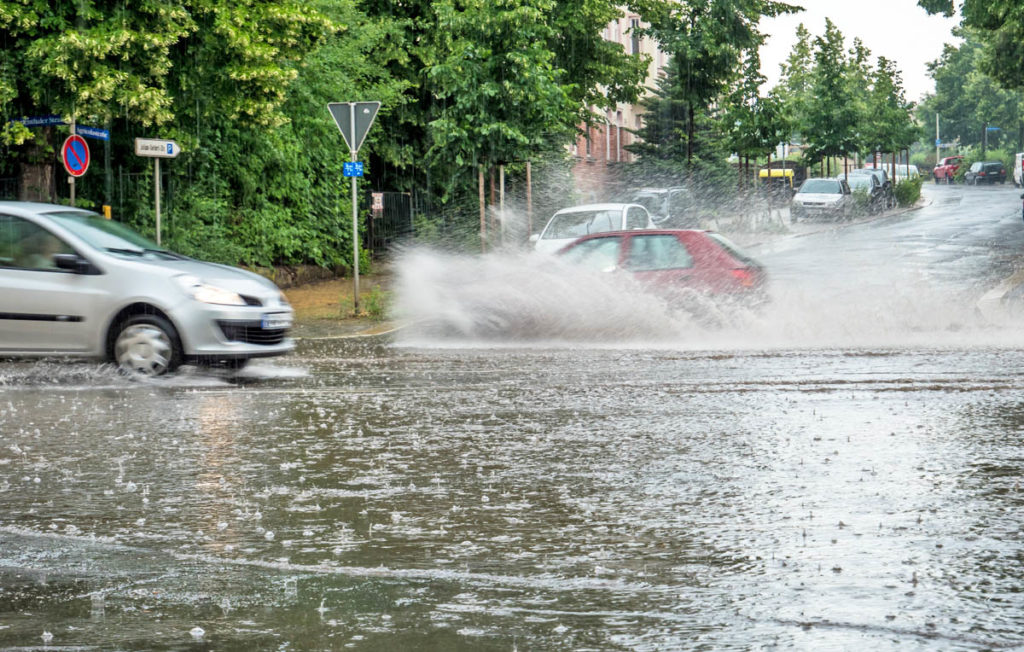
In the long term, the changes in the regional water balance as a result of climate change will be reflected in impacts on groundwater levels, river discharge regimes and changes in water quality, but also in the more frequent occurrence of extreme events (e.g. floods, heavy rainfall, droughts). Water availability is also coming under greater scrutiny as a result of the low precipitation years 2018, 2019 and 2020, especially where it relies on punctual water withdrawals, e.g. from spring discharges.
Impacts
- Exceeding the capacity of wastewater disposal systems
- Damage to water supply and wastewater disposal infrastructure
- Possible contamination of drinking water
Initiatives
- Approaching the natural water balance
- Creation of retention area, construction of polders, retention basins, dams and weirs
- Preparation of heavy rainfall hazard maps
- Checking and securing sources of contamination in the flood area
- Promotion of natural vegetation
A dry period is when less than 1mm of precipitation falls on at least four consecutive days. An increasing trend of dry periods is expected. The consequences of prolonged dry periods can be droughts and low water.
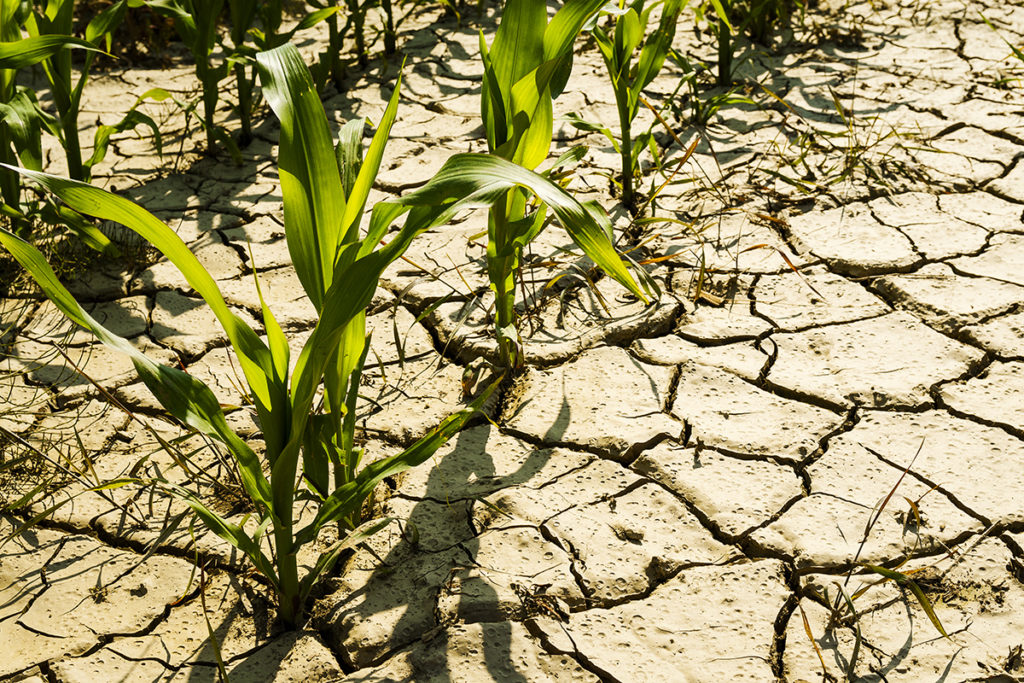
In the long term, the changes in the regional water balance as a result of climate change will be reflected in impacts on groundwater levels, river discharge regimes and changes in water quality, but also in the more frequent occurrence of extreme events (e.g. floods, heavy rainfall, droughts). Water availability is also coming under greater scrutiny as a result of the low precipitation years 2018, 2019 and 2020, especially where it relies on punctual water withdrawals, e.g. from spring discharges.
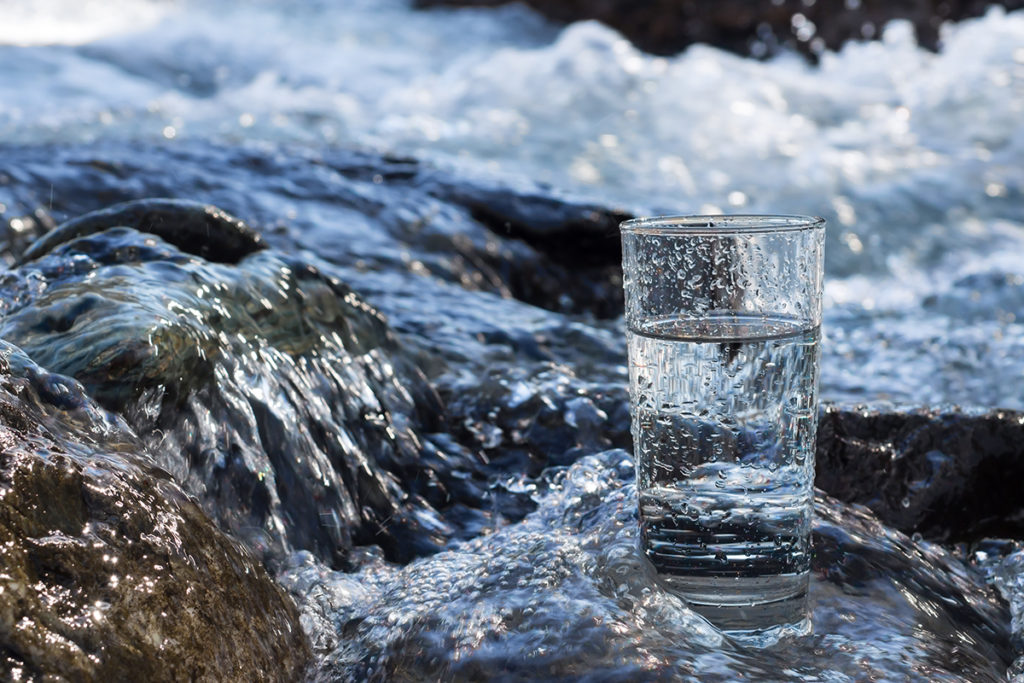
Climate change has multiple impacts on human health. Thermal stress due to heat waves, increased UV radiation as well as extreme weather events and related accident hazards are directly attributable to climate change. Non-communicable diseases (such as cardiovascular diseases and allergies) may increase as well as infectious diseases due to food and drinking water hygiene problems.

Of particular concern for urban and spatial planning is the increased heat load, flooding due to heavy rain and floods, and the increased drought. The strong warming of sealed inner-city areas (urban heat island effect) increases the thermal load in densely populated areas. Floods and heavy rainfall have a high damage potential and lead, among other things, to threats to critical infrastructure. Urban and spatial planning can promote climate-adapted planning in many ways and contribute to adaptation to the consequences of climate change with its control tools.
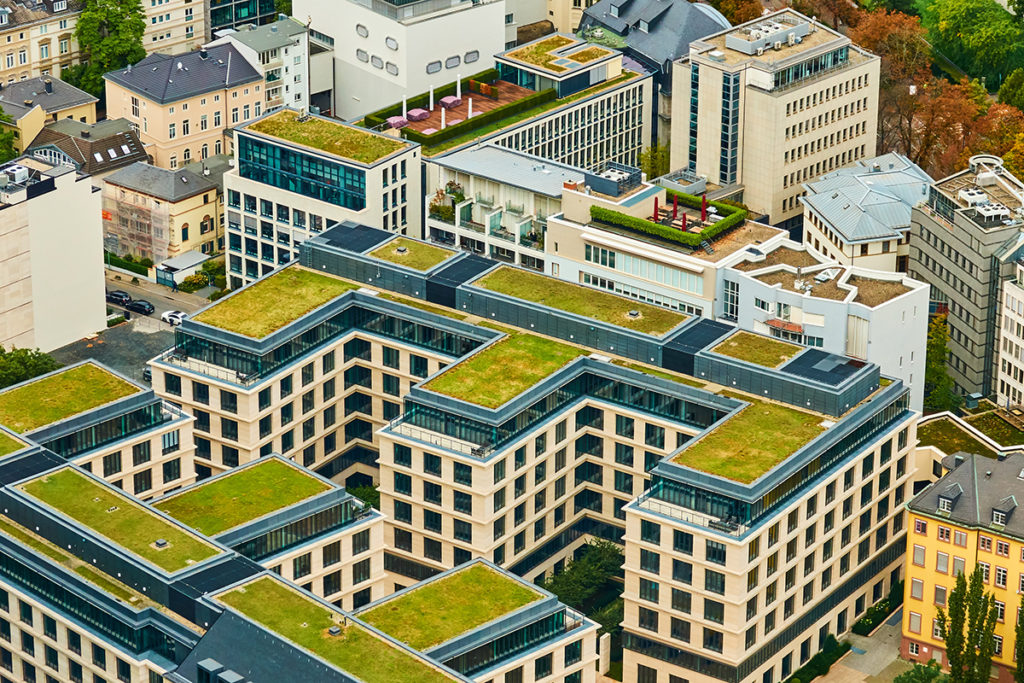
Extreme storms, hail, heat and flooding can cause high damage to private and public buildings. Such extreme weather events may occur more frequently and be more severe due to climate change, increasing the risk of damage. Not all potential damage can be covered by insurance.

Temperature and precipitation usually have a very direct impact on species and their habitats. Many species and habitats are already endangered in their populations and distribution. Climate change may exacerbate this development in the future. Due to climate change, plant and animal species either adapt, migrate or become extinct in their previous habitats. Some species also benefit from climate change because, for example, their habitat expands. Particularly negative consequences of climate change can already be observed today for species that are exclusively native to mountain regions and for species with a strong specialisation in very small-scale locations.
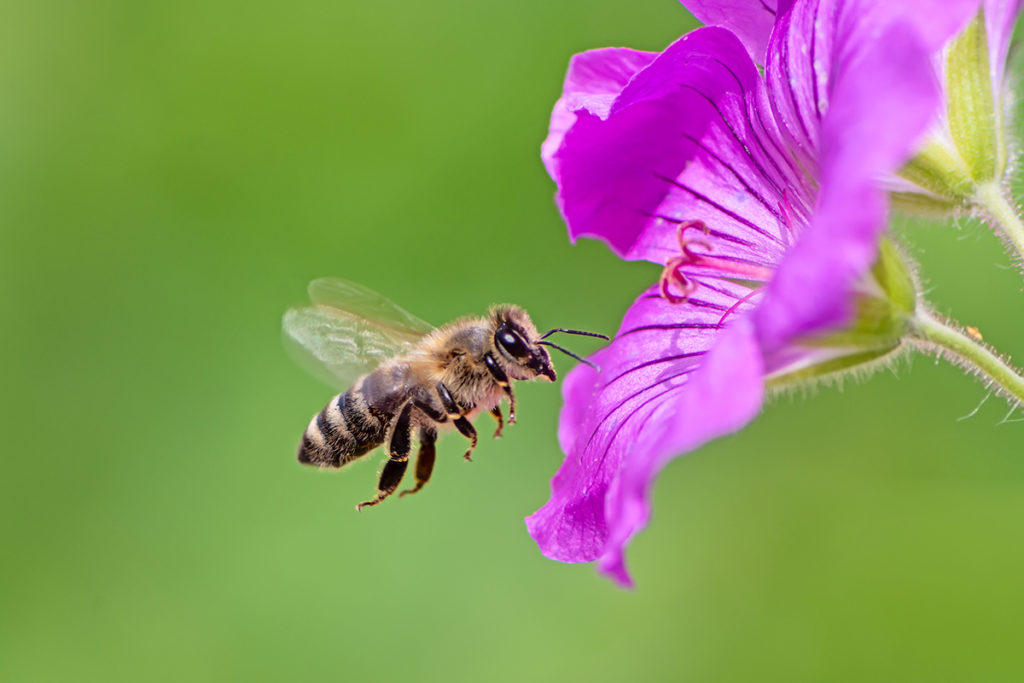
Agriculture is directly affected by the consequences of climate change. Continuous climatic changes as well as weather and weather extremes such as hail, floods, storms, drought and heat as well as early and late frosts influence cultivation conditions and production possibilities. Extreme events whose local occurrence cannot be precisely predicted are particularly problematic here. They can lead to considerable economic losses. Climate change also influences soil properties and can thus impair soil performance. Changing precipitation regimes can cause increases in water runoff and soil erosion, or increased soil compaction. Increasing temperatures may lead to a reduction of humus and a change in the diversity and activity of soil organisms.
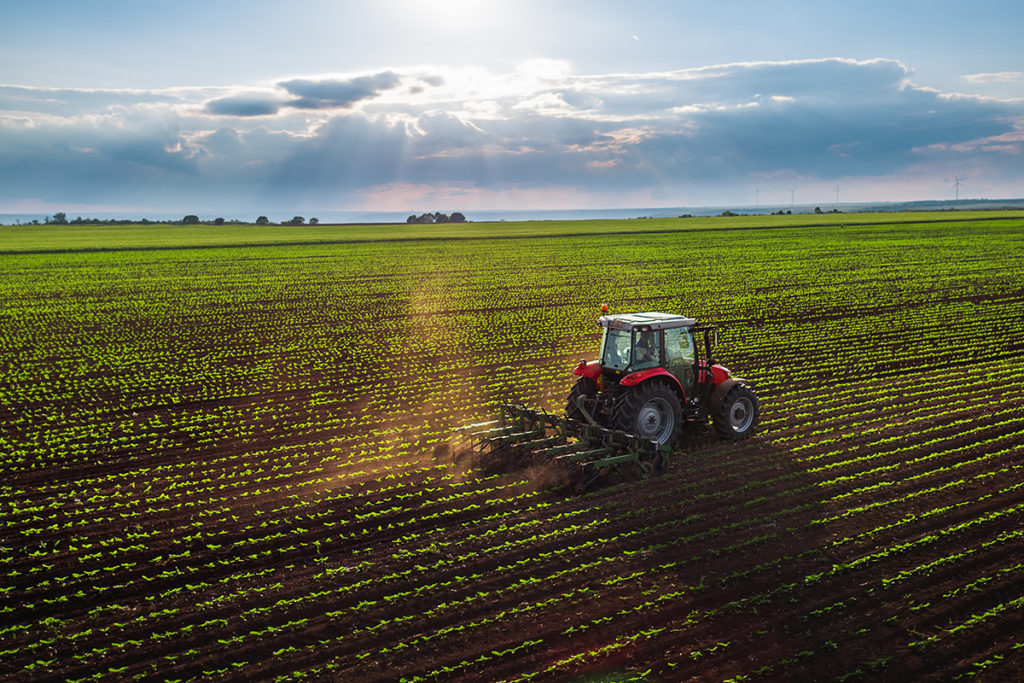
Forests can make an important contribution to climate protection and at the same time have cooling effects on their surroundings during hot spells. However, the consequences of climate change, especially increasingly frequent and prolonged dry and hot phases, are putting a strain on forests and posing challenges for forest owners and forest managers. Forests are not only threatened by increasingly frequent fires. The trees weakened by drought are also less resistant to strong wind events or pests, such as the bark beetle.
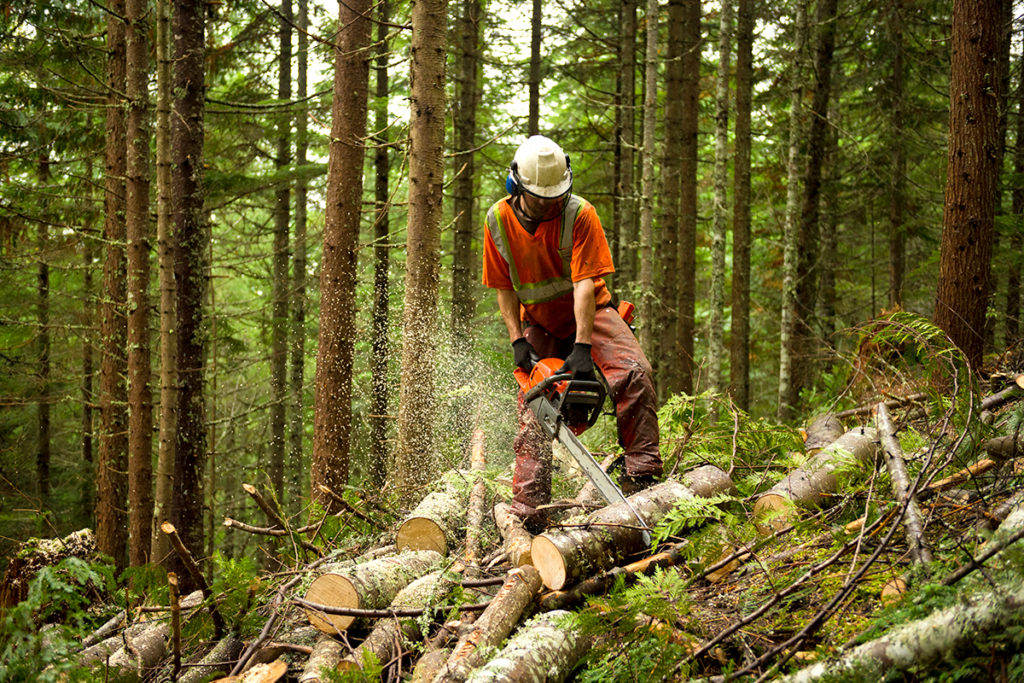
Climate change also has an impact on the energy industry. A general rise in temperature may on the one hand reduce the demand for heating energy in the winter months, while on the other hand increase the demand for cooling energy during increasingly warmer summer months. Extreme weather events such as storms, droughts, low and high water can affect the operation of energy supply plants and facilities. An example of this is the dependence of thermal power plants on the availability of sufficient cooling water for electricity generation, which is usually taken from rivers. During summer low water levels, there are increasingly frequent restrictions on power plant operations.
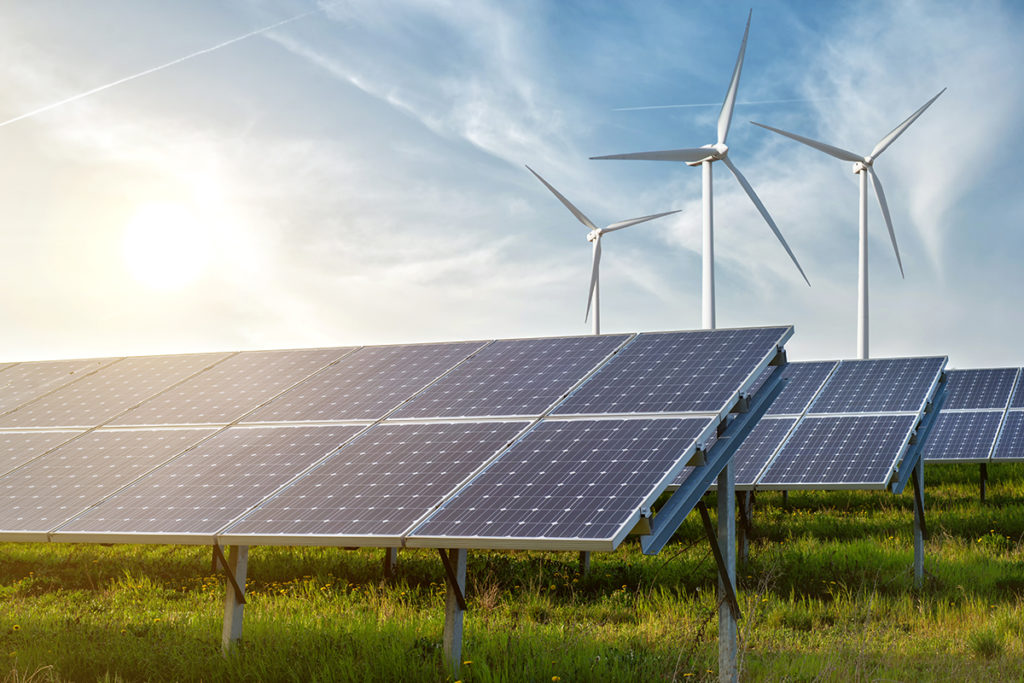
Climate change can bring both risks and opportunities for the economy. The direct and indirect impacts of climate change are extremely diverse and depend on the size, location, structure and sector. Both direct location-related risks (e.g. operating facilities damaged by extreme weather) and cascading effects, for example problems in the supply chains due to blocked transport routes or extreme events with negative impacts at foreign production locations, must be identified.

Extreme weather events are increasingly causing disruptions to traffic on roads, railways, in the water and in the air. Landslides and undercutting, but also extreme heat, can lead to the destabilisation and destruction of roads, footpaths and sections of railway lines. Storms can directly cause obstructions or damage roads, tracks and power lines via windthrow. Extreme events also change the demand for different modes of transport, for example when pedestrians and cyclists switch to cars or public transport due to high heat.
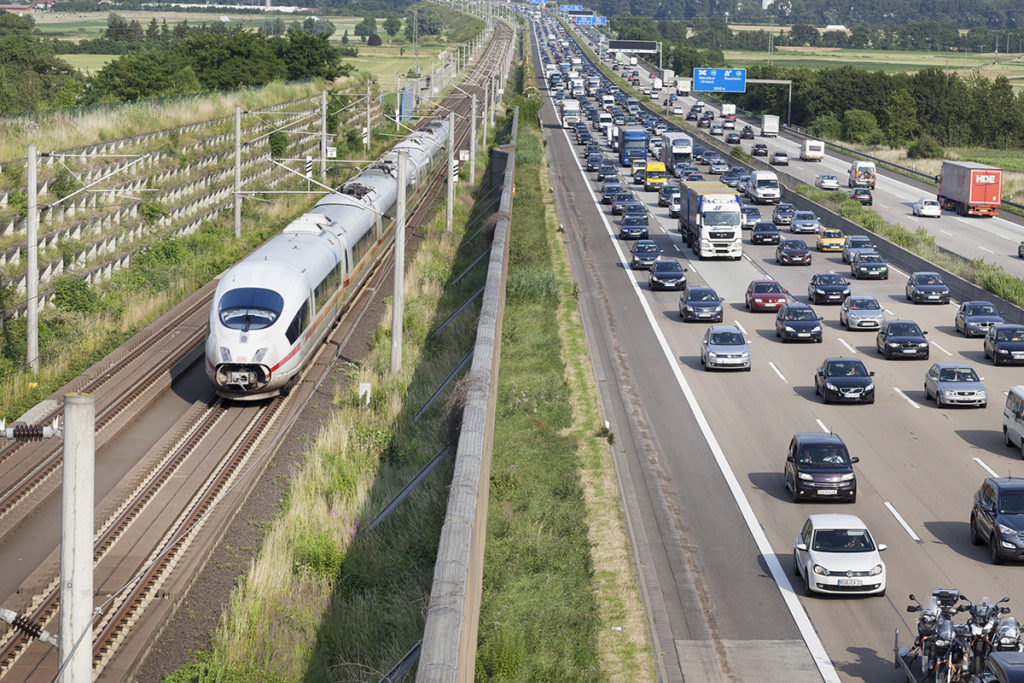
For tourism, climate change brings both opportunities and risks. In the medium to long term, winter sports locations in Germany are likely to lose out, as snow reliability in the low mountain ranges will decline as the climate warms. Summer tourism, on the other hand, could benefit from climate change: through a shift in tourism flows from the currently popular Mediterranean regions and an extended season with warmer and drier weather for swimming, camping and hiking holidays.

The effects of climate change must also be taken into account in the area of civil protection. The focus here is on efforts to optimise or expand existing structures in emergency and rescue services as well as disaster management. The aim here is not only to react quickly and effectively in the event of extreme weather events (heat waves, floods, inundations, heavy rainfall events, storms) but also to prepare for disasters against the background of changing climatic conditions. The focus here is on both population protection and the protection of critical infrastructures.
Impacts
- Heat-related operations are increasing, e.g. forest fires, oxygen addition in eutrophic, stagnant waters
- Thermal stress on emergency forces and machinery is increasing
Climate change has multiple impacts on human health. Thermal stress due to heat waves, increased UV radiation as well as extreme weather events and related accident hazards are directly attributable to climate change. Non-communicable diseases (such as cardiovascular diseases and allergies) may increase as well as infectious diseases due to food and drinking water hygiene problems.
Impacts
- Deaths and injuries due to flooding
- Danger to life and limb increases
- Psychological stress due to loss of personal belongings or house due to extreme precipitation (e.g. post-traumatic stress disorder)
- Risk of medical bottlenecks during major damage events (including storms) increases
- Drinking water can be contaminated by bacteria
Initiatives
- Short-term precipitation forecast: Communicate severe weather warning (email/SMS/messages/apps)
- Longer-term behavioral precautions: communicate information about hazard situation
of a property and about possibilities precautionary measures
Of particular concern for urban and spatial planning is the increased heat load, flooding due to heavy rain and floods, and the increased drought. The strong warming of sealed inner-city areas (urban heat island effect) increases the thermal load in densely populated areas. Floods and heavy rainfall have a high damage potential and lead, among other things, to threats to critical infrastructure. Urban and spatial planning can promote climate-adapted planning in many ways and contribute to adaptation to the consequences of climate change with its control tools.
Impacts
- Flooding/ high water
- Commercial and residential areas at risk
- Building and storm drainage and sewage disposal systems overloaded
Initiatives
- Use of social media and communication channels (warning apps, radio announcements) to warn and change behavior
- Creation of heavy rain hazard maps
- Development of multifunctional green and open spaces
- Review and, if necessary, expansion of retention and renaturation measures
- Rainwater management (e.g. rainwater harvesting, trench systems)
- Use of water-permeable, climate-friendly and durable path surfaces (e.g. bone stones, split)
- Advanced training on the subject of heavy rainfall prevention (e.g. by the DWA: Fachplaner Starkregen)
- Anchoring of heavy rain precautions in urban land use plans
Extreme storms, hail, heat and flooding can cause high damage to private and public buildings. Such extreme weather events may occur more frequently and be more severe due to climate change, increasing the risk of damage. Not all potential damage can be covered by insurance.
Impacts
- Damage to buildings, damage to property (also due to floods, high water and landslides)
Initiatives
- Consideration of urban climatic aspects in building planning
- Keeping flood plains free
- Support and promotion of unsealing
- Use of social media and communication channels (warning apps, radio announcements) to warn and change behavior
- Flood-adapted building design and construction (waterproofing or tiling basements, relocating heating systems and electrical installations to upper floors, securing heating oil tanks, placing electrical appliances on landings)
- Stormwater management (e.g., rainwater harvesting, infiltration systems)
- Keeping floodplains clear and creating infiltration areas (e.g., by breaking curbs)
- Construction of sills, walls, and (mobile) sheet pile walls to protect low-lying areas (e.g., basements, building entrances, underground garages)
Temperature and precipitation usually have a very direct impact on species and their habitats. Many species and habitats are already endangered in their populations and distribution. Climate change may exacerbate this development in the future. Due to climate change, plant and animal species either adapt, migrate or become extinct in their previous habitats. Some species also benefit from climate change because, for example, their habitat expands. Particularly negative consequences of climate change can already be observed today for species that are exclusively native to mountain regions and for species with a strong specialisation in very small-scale locations.
Impacts
- Damage to ecosystems
- Damage to the tree population
- Habitat shifts due to ecosystem damage
Initiatives
- Development of large-scale biotope network systems
Agriculture is directly affected by the consequences of climate change. Continuous climatic changes as well as weather and weather extremes such as hail, floods, storms, drought and heat as well as early and late frosts influence cultivation conditions and production possibilities. Extreme events whose local occurrence cannot be precisely predicted are particularly problematic here. They can lead to considerable economic losses. Climate change also influences soil properties and can thus impair soil performance. Changing precipitation regimes can cause increases in water runoff and soil erosion, or increased soil compaction. Increasing temperatures may lead to a reduction of humus and a change in the diversity and activity of soil organisms.
Impacts
- Soil erosion and siltation increases
- Soil is more difficult for machines to work
- Risk of lower yields and degradation increases
- Landslides increase on slopes with increased maintenance costs
- Footfall damage on pastures increases
Initiatives
- Water retention in reservoirs and retention areas
- Use of social media and communication channels (warning apps, radio announcements) for warning and behavioural change
- Unsealing of areas
- Construction of earth dams and terraces as well as backfilling of areas
- Creation of green and hedge strips parallel to the slope > Drainage measures
Forests can make an important contribution to climate protection and at the same time have cooling effects on their surroundings during hot spells. However, the consequences of climate change, especially increasingly frequent and prolonged dry and hot phases, are putting a strain on forests and posing challenges for forest owners and forest managers. Forests are not only threatened by increasingly frequent fires. The trees weakened by drought are also less resistant to strong wind events or pests, such as the bark beetle.
Impacts
- Damage to the tree population
- Erosion on slopes
- Increasing need for traffic safety measures (e.g. dead branches)
Initiatives
- Use of social media and communication channels (warning apps, radio announcements) to warn and change behaviour
- Long-term conversion to near-natural mixed forests
- Increase in wetland biotopes for water retention
- Creation of infiltration troughs
Climate change also has an impact on the energy industry. A general rise in temperature may on the one hand reduce the demand for heating energy in the winter months, while on the other hand increase the demand for cooling energy during increasingly warmer summer months. Extreme weather events such as storms, droughts, low and high water can affect the operation of energy supply plants and facilities. An example of this is the dependence of thermal power plants on the availability of sufficient cooling water for electricity generation, which is usually taken from rivers. During summer low water levels, there are increasingly frequent restrictions on power plant operations.
Impacts
- Damage to energy supply infrastructure
- Yield losses in biomass production
Initiatives
- Structural securing of energy supply infrastructure
- Elevation of distribution boxes
Climate change can bring both risks and opportunities for the economy. The direct and indirect impacts of climate change are extremely diverse and depend on the size, location, structure and sector. Both direct location-related risks (e.g. operating facilities damaged by extreme weather) and cascading effects, for example problems in the supply chains due to blocked transport routes or extreme events with negative impacts at foreign production locations, must be identified.
Impacts
- Damage to buildings and equipment (due to direct damage, washout and undercutting, and landslides)
- loods can cause damage to operational buildings, production facilities and inventories
Initiatives
- Systematic, forward-looking risk management
- Diversification of suppliers
- Insurance against natural hazards
- Identification of critical supply components
- Relocation of critical equipment (e.g. IT) to higher parts of the building
- Creation of drainage and infiltration areas
- Structural preventive measures
Extreme weather events are increasingly causing disruptions to traffic on roads, railways, in the water and in the air. Landslides and undercutting, but also extreme heat, can lead to the destabilisation and destruction of roads, footpaths and sections of railway lines. Storms can directly cause obstructions or damage roads, tracks and power lines via windthrow. Extreme events also change the demand for different modes of transport, for example when pedestrians and cyclists switch to cars or public transport due to high heat.
Impacts
- Transport infrastructure is damaged (flooding and undermining of road sections, underpasses and railroad tracks, landslides)
- Maintenance costs increase
- Expenditure for traffic safety measures increase
Initiatives
- Slope stabilisation and structural protection of transport infrastructure (e.g. rockfall nets, drainage measures)
- Use of social media and communication channels (warning apps, radio announcements) to warn and change behaviour
- Regular driver safety training
For tourism, climate change brings both opportunities and risks. In the medium to long term, winter sports locations in Germany are likely to lose out, as snow reliability in the low mountain ranges will decline as the climate warms. Summer tourism, on the other hand, could benefit from climate change: through a shift in tourism flows from the currently popular Mediterranean regions and an extended season with warmer and drier weather for swimming, camping and hiking holidays.
Impacts
- Bathing lakes, campsites, swimming pools are impacted and use is limited
- Outdoor activity infrastructure is affected (e.g., interruption of MTB routes, access routes, destruction of water-related infrastructure and objects)
- Festivals have to be cancelled due to severe weather conditions
- Damage to buildings, monuments, and cultural facilities increases
Initiatives
- Use of social media and communication channels (warning apps, radio announcements) to warn and change behaviour
- Strengthening of weather-independent (indoor) offers
The effects of climate change must also be taken into account in the area of civil protection. The focus here is on efforts to optimise or expand existing structures in emergency and rescue services as well as disaster management. The aim here is not only to react quickly and effectively in the event of extreme weather events (heat waves, floods, inundations, heavy rainfall events, storms) but also to prepare for disasters against the background of changing climatic conditions. The focus here is on both population protection and the protection of critical infrastructures.
Impacts
- Floods/ high water
- Damage to private residences, farm buildings, public structures, and infrastructure (e.g., roads/bridges) from flooding and high water
- Overloading of drainage and sewage disposal systems
- Increasing demand for emergency services
Initiatives
- Establishment and further development of efficient warning and information systems
- Social media communication
- Identification and protection of critical infrastructure
- Improving self-protection and self-help capabilities
- Equipment pool
- Emergency plans
Climate change has multiple impacts on human health. Thermal stress due to heat waves, increased UV radiation as well as extreme weather events and related accident hazards are directly attributable to climate change. Non-communicable diseases (such as cardiovascular diseases and allergies) may increase as well as infectious diseases due to food and drinking water hygiene problems.
Impacts
- Levels of drinking water wells drop
- Drinking water demand increases in combination with heat waves
- Air quality deteriorates due to (fine) dust and other air pollutants (reduced “wash-out effect”)
- Higher ozone levels increase health risks (summer smog)
Initiatives
- Promotion of tree and bush planting as well as roof and facade greening with low-allergen plants to improve air quality
- Preventive measures against the spread of allergenic animal and plant species (e.g. ragweed)
Of particular concern for urban and spatial planning is the increased heat load, flooding due to heavy rain and floods, and the increased drought. The strong warming of sealed inner-city areas (urban heat island effect) increases the thermal load in densely populated areas. Floods and heavy rainfall have a high damage potential and lead, among other things, to threats to critical infrastructure. Urban and spatial planning can promote climate-adapted planning in many ways and contribute to adaptation to the consequences of climate change with its control tools.
Impacts
- Water becomes scarcer (drinking water, service water, water for fire-fighting)
- Wastewater infrastructure is impaired, e.g. odor development in the sewage system
- Trees and green spaces are damaged
Initiatives
- Promoting tree and shrub plantings as well as green roofs and facades with heat/drought-tolerant plants
- Ensuring the irrigation of public green spaces and parks
- Tree protection statutes to preserve the existing tree population in the urban area
- Promotion of rainwater harvesting on private property and public areas (e.g., through rainwater ponds and tanks)
Extreme storms, hail, heat and flooding can cause high damage to private and public buildings. Such extreme weather events may occur more frequently and be more severe due to climate change, increasing the risk of damage. Not all potential damage can be covered by insurance.
Impacts
- Water is becoming scarcer (drinking water, service water, water for firefighting)
- Water demand for garden irrigation and pools increases
Initiatives
- Use of social media and communication channels (warning apps, radio announcements) to warn and change behavior
- Promoting rainwater harvesting on private property and public spaces (e.g., through rainwater ponds and watertanks)
In the long term, the changes in the regional water balance as a result of climate change will be reflected in impacts on groundwater levels, river discharge regimes and changes in water quality, but also in the more frequent occurrence of extreme events (e.g. floods, heavy rainfall, droughts). Water availability is also coming under greater scrutiny as a result of the low precipitation years 2018, 2019 and 2020, especially where it relies on punctual water withdrawals, e.g. from spring discharges.
Impacts
- Levels of surface waters are falling
- Water becomes scarcer (drinking water, service water, water for fire-fighting)
- Spring discharges dry up and groundwater quality decreases (-> drinking water)
Quality of surface waters decreases - Algae blooms, fish kills and drying out of wetland biotopes increas
- Increased need for irrigation of public green spaces and private gardens
- Conflicts of use due to generally increasing demand
Initiatives
- Formation of supra-local water supply systems
- Promotion of water-saving measures for private households, businesses and municipalities (through general calls to save water, withdrawal bans)
- Organization of an irrigation management system
- Creation of an irrigation management system
- Securing public drinking water wells
- Reducing consumption during hot spells (through general calls to save water, consumption limits, limiting the withdrawal of cooling water from natural bodies of water)
Temperature and precipitation usually have a very direct impact on species and their habitats. Many species and habitats are already endangered in their populations and distribution. Climate change may exacerbate this development in the future. Due to climate change, plant and animal species either adapt, migrate or become extinct in their previous habitats. Some species also benefit from climate change because, for example, their habitat expands. Particularly negative consequences of climate change can already be observed today for species that are exclusively native to mountain regions and for species with a strong specialisation in very small-scale locations.
Impacts
- Weakening of forests, death of individual tree species
- Water level fluctuations and deterioration of water quality
- Surface waters dry up
- Springs dry up
- Forests and vegetation are under drought stress
- Leaf fall occurs earlier
- Shrinkage cracks can form in the soil
- Forest or moorland fires and wildfires increase
Initiatives
- Expansion of tree population to include native, site-appropriate species with greater tolerance to heat and drought.
- General diversification of the tree population
Agriculture is directly affected by the consequences of climate change. Continuous climatic changes as well as weather and weather extremes such as hail, floods, storms, drought and heat as well as early and late frosts influence cultivation conditions and production possibilities. Extreme events whose local occurrence cannot be precisely predicted are particularly problematic here. They can lead to considerable economic losses. Climate change also influences soil properties and can thus impair soil performance. Changing precipitation regimes can cause increases in water runoff and soil erosion, or increased soil compaction. Increasing temperatures may lead to a reduction of humus and a change in the diversity and activity of soil organisms.
Impacts
- Water and feed becomes scarce
- Demand for irrigation and watering increases
- Risk of yield and quality losses increases
- Soil erosion, dust storms and drought cracking occur more frequently
- New drought- and heat-loving pests and diseases expand
- Water absorption capacity of soil by crusting and air-filled soil pores is reduced –> Soil erosion increases when precipitation falls on dried-out soils
Initiatives
- Humus-amplifying management
- Recording and evaluation of areas at risk of erosion
- Precautionary soil protection
- Soil-conserving management to avoid soil compaction and erosion and to increase water storage capacity
- Promotion of irrigation systems and rainwater storage systems
Forests can make an important contribution to climate protection and at the same time have cooling effects on their surroundings during hot spells. However, the consequences of climate change, especially increasingly frequent and prolonged dry and hot phases, are putting a strain on forests and posing challenges for forest owners and forest managers. Forests are not only threatened by increasingly frequent fires. The trees weakened by drought are also less resistant to strong wind events or pests, such as the bark beetle.
Impacts
- Increased risk of forest fires
- Drought stress makes trees more susceptible to pests such as bark beetles
- Potentially lower growth and lower CO2 storage capacity due to drought stress increases
Initiatives
- Financing and equipping the volunteer fire brigades to fight forest fires
- Increased deployment of personnel to ensure road safety along roads, tracks and paths
- Diversification of tree species
Climate change also has an impact on the energy industry. A general rise in temperature may on the one hand reduce the demand for heating energy in the winter months, while on the other hand increase the demand for cooling energy during increasingly warmer summer months. Extreme weather events such as storms, droughts, low and high water can affect the operation of energy supply plants and facilities. An example of this is the dependence of thermal power plants on the availability of sufficient cooling water for electricity generation, which is usually taken from rivers. During summer low water levels, there are increasingly frequent restrictions on power plant operations.
Impacts
- Increased electricity consumption due to cooling energy demand in summer
- Reduced electricity production in hydropower plants due to reduced runoff volumes
- Damage and failure of technical equipment due to overheating
- Yield losses in biomass production
Initiatives
- Expansion of storage management (e.g. of hydropower plants)
Climate change can bring both risks and opportunities for the economy. The direct and indirect impacts of climate change are extremely diverse and depend on the size, location, structure and sector. Both direct location-related risks (e.g. operating facilities damaged by extreme weather) and cascading effects, for example problems in the supply chains due to blocked transport routes or extreme events with negative impacts at foreign production locations, must be identified.
Impacts
- Impacts primarily on production processes that rely on water
Initiatives
- Systematic, forward-looking risk management
- Diversification of suppliers
- Insurance against natural hazards
- Identification of critical supply components
- Provision of drinking water
- Structural preventive measures
Extreme weather events are increasingly causing disruptions to traffic on roads, railways, in the water and in the air. Landslides and undercutting, but also extreme heat, can lead to the destabilisation and destruction of roads, footpaths and sections of railway lines. Storms can directly cause obstructions or damage roads, tracks and power lines via windthrow. Extreme events also change the demand for different modes of transport, for example when pedestrians and cyclists switch to cars or public transport due to high heat.
Impacts
- Levels of surface waters fall
- Low discharge levels lead to obstructions to shipping traffic: reduced tonnage, closure of waterways
- Demand for traffic safety measures increases, e.g. danger from falling dead branches in road traffic
Initiatives
- Establish substitute structures for delivery on other transport routes (roads or railways)
For tourism, climate change brings both opportunities and risks. In the medium to long term, winter sports locations in Germany are likely to lose out, as snow reliability in the low mountain ranges will decline as the climate warms. Summer tourism, on the other hand, could benefit from climate change: through a shift in tourism flows from the currently popular Mediterranean regions and an extended season with warmer and drier weather for swimming, camping and hiking holidays.
Impacts
- Water levels decrease –> Bathing water quality impaired e.g. blue-green algae, oxygen deficiency, pollutant accumulation
- Risk of water shortage for tourist offers increases (golf courses, pools, snowmaking)
Initiatives
- Increased testing of bathing water quality and development of communication channels of the resulting results (e-mail/SMS/messages/apps)
The effects of climate change must also be taken into account in the area of civil protection. The focus here is on efforts to optimise or expand existing structures in emergency and rescue services as well as disaster management. The aim here is not only to react quickly and effectively in the event of extreme weather events (heat waves, floods, inundations, heavy rainfall events, storms) but also to prepare for disasters against the background of changing climatic conditions. The focus here is on both population protection and the protection of critical infrastructures.
Impacts
- Increased risk of forest fires
- Threat to drinking water supply (quality and reserves)
Initiatives
- Establishment and further development of efficient warning and information systems
- Social media communication
- Identification and protection of critical infrastructure
- Improving self-protection and self-help capabilities
- Equipment pool
- Emergency plans
For tourism, climate change brings both opportunities and risks. In the medium to long term, winter sports locations in Germany are likely to lose out, as snow reliability in the low mountain ranges will decline as the climate warms. Summer tourism, on the other hand, could benefit from climate change: through a shift in tourism flows from the currently popular Mediterranean regions and an extended season with warmer and drier weather for swimming, camping and hiking holidays.
Impacts
- Bathing water quality is affected
- Low water levels affect tourist navigation
- Longer summer season and higher revenues for fair-weather-dependent outdoor tourism
- Risk of water shortage for tourist offers increases (golf courses, pools)
Initiatives
- Diversification of the tourist offer in other areas
- Increased monitoring of bathing water quality and expansion of communication channels of the resulting results (e-mail/SMS/messages/apps)
Climate change can bring both risks and opportunities for the economy. The direct and indirect impacts of climate change are extremely diverse and depend on the size, location, structure and sector. Both direct location-related risks (e.g. operating facilities damaged by extreme weather) and cascading effects, for example problems in the supply chains due to blocked transport routes or extreme events with negative impacts at foreign production locations, must be identified.
Impacts
- Summer precipitation decreases
- Longer dry spells and more intense heavy rainfall events
- Water levels in surface waters decrease
- Agriculture severely impaired due to increasing need for irrigation
- Yield and quality losses in some areas
- Longer summer season and higher sales for industries dependent on good weather, e.g. outdoor restaurants, outdoor pools, ice cream parlors, swimming pool construction
Initiatives
- Expansion of irrigation infrastructure in agriculture
- Diversification of varieties
Climate change also has an impact on the energy industry. A general rise in temperature may on the one hand reduce the demand for heating energy in the winter months, while on the other hand increase the demand for cooling energy during increasingly warmer summer months. Extreme weather events such as storms, droughts, low and high water can affect the operation of energy supply plants and facilities. An example of this is the dependence of thermal power plants on the availability of sufficient cooling water for electricity generation, which is usually taken from rivers. During summer low water levels, there are increasingly frequent restrictions on power plant operations.
Impacts
- Summer precipitation decreases
- Longer dry phases and more intense heavy rainfall events
- Water levels in surface waters fall
- Water becomes scarce (drinking water, service water, water for firefighting)
- Electricity production in hydropower plants decreases due to reduced runoff volumes
- Security of supply decreases, especially for cooling water-dependent energy production
Yields from biomass production decrease
Initiatives
- Investments for flood protection facilities and creation of retention areas to protect central infrastructure facilities
Forests can make an important contribution to climate protection and at the same time have cooling effects on their surroundings during hot spells. However, the consequences of climate change, especially increasingly frequent and prolonged dry and hot phases, are putting a strain on forests and posing challenges for forest owners and forest managers. Forests are not only threatened by increasingly frequent fires. The trees weakened by drought are also less resistant to strong wind events or pests, such as the bark beetle.
Impacts
- Summer precipitation decreases
- Longer dry phases and more intense heavy rainfall events
- Water levels in surface waters fall
- Water becomes scarce (drinking water, service water, water for firefighting)
- Susceptibility to pests increases due to drought stress
- Demand for traffic safety measures increases (e.g. removal of dead branches)
Initiatives
- Diversification of tree species
- Pest control measures
Extreme storms, hail, heat and flooding can cause high damage to private and public buildings. Such extreme weather events may occur more frequently and be more severe due to climate change, increasing the risk of damage. Not all potential damage can be covered by insurance.
Impacts
- Summer precipitation decreases
- Longer dry periods and more intense heavy rainfall events
- Water demand increases (drinking water, hygiene, service water, irrigation, pools)
Initiatives
- Use of cisterns and water storage tanks
- Reducing consumption during hot spells (through general calls to save water, consumption limits for garden watering)
Climate change has multiple impacts on human health. Thermal stress due to heat waves, increased UV radiation as well as extreme weather events and related accident hazards are directly attributable to climate change. Non-communicable diseases (such as cardiovascular diseases and allergies) may increase as well as infectious diseases due to food and drinking water hygiene problems.
Impacts
- Flood risk with danger to life and limb increases
- Traumatic stress for flood victims
Extreme storms, hail, heat and flooding can cause high damage to private and public buildings. Such extreme weather events may occur more frequently and be more severe due to climate change, increasing the risk of damage. Not all potential damage can be covered by insurance.
Impacts
- Flood risk with danger to life and limb increases
- Particularly affected are low-lying areas, areas near water bodies and underpasses
- Spatial disposition is broken down in flood risk maps
- Building damage due to water, moisture and entrained debris
Initiatives
- Green roofs as retention areas and to relieve the burden on the sewage system
Climate change also has an impact on the energy industry. A general rise in temperature may on the one hand reduce the demand for heating energy in the winter months, while on the other hand increase the demand for cooling energy during increasingly warmer summer months. Extreme weather events such as storms, droughts, low and high water can affect the operation of energy supply plants and facilities. An example of this is the dependence of thermal power plants on the availability of sufficient cooling water for electricity generation, which is usually taken from rivers. During summer low water levels, there are increasingly frequent restrictions on power plant operations.
Impacts
- Central utilities are at risk from flooding
Initiatives
- Survey of the vulnerability of the supply network to flooding and creation of replacement structures if required
- Investments for flood protection facilities and creation of retention areas to protect central infrastructure facilities
The effects of climate change must also be taken into account in the area of civil protection. The focus here is on efforts to optimise or expand existing structures in emergency and rescue services as well as disaster management. The aim here is not only to react quickly and effectively in the event of extreme weather events (heat waves, floods, inundations, heavy rainfall events, storms) but also to prepare for disasters against the background of changing climatic conditions. The focus here is on both population protection and the protection of critical infrastructures.
Impacts
- Operations in the winter months increase due to flooding
- Flooding in heavily sealed areas leads to damage to building fabric, traffic routes, etc.
- Drainage and wastewater disposal systems are overloaded
- Drinking water contamination can endanger drinking water supplies
- Risk of flooding and inundation due to precipitation in the winter months increases
Initiatives
- Establishment and further development of efficient warning and information systems
- Development of emergency plans with the disaster control authorities
- Identification and protection of critical infrastructure
- Improvement of self-protection and self-help capabilities
- Training of personnel and necessary equipment
- Preparation of emergency plans
Extreme storms, hail, heat and flooding can cause high damage to private and public buildings. Such extreme weather events may occur more frequently and be more severe due to climate change, increasing the risk of damage. Not all potential damage can be covered by insurance.
Impacts
- Wet snow on the rise in high-altitude communities
- Static loads and damage to buildings increase
- More frequent frost changes lead to higher loads
Initiatives
- Regular inspection of the buildings for structural defects
Forests can make an important contribution to climate protection and at the same time have cooling effects on their surroundings during hot spells. However, the consequences of climate change, especially increasingly frequent and prolonged dry and hot phases, are putting a strain on forests and posing challenges for forest owners and forest managers. Forests are not only threatened by increasingly frequent fires. The trees weakened by drought are also less resistant to strong wind events or pests, such as the bark beetle.
Impacts
- Species spectrum shifts toward warmth-loving tree species
- Risk of snow and ice breakage increases due to increase in wet snow and freezing rain (also in urban areas)
Initiatives
- Conversion to more heat-loving and drought-resistant species (forest conversion) and promotion of near-natural mixed forests
- Use of smaller machines or (in areas particularly worthy of protection) horses to remove wood
Climate change also has an impact on the energy industry. A general rise in temperature may on the one hand reduce the demand for heating energy in the winter months, while on the other hand increase the demand for cooling energy during increasingly warmer summer months. Extreme weather events such as storms, droughts, low and high water can affect the operation of energy supply plants and facilities. An example of this is the dependence of thermal power plants on the availability of sufficient cooling water for electricity generation, which is usually taken from rivers. During summer low water levels, there are increasingly frequent restrictions on power plant operations.
Impacts
- Wärmebedarf im Winter nimmt ab, Kühlbedarf im Sommer steigt
- Heating demand in winter decreases, cooling demand in summer increases
Initiatives
- Ensure and expand heating and cooling via renewable energies, create networking structures, increase storage capacity
Of particular concern for urban and spatial planning is the increased heat load, flooding due to heavy rain and floods, and the increased drought. The strong warming of sealed inner-city areas (urban heat island effect) increases the thermal load in densely populated areas. Floods and heavy rainfall have a high damage potential and lead, among other things, to threats to critical infrastructure. Urban and spatial planning can promote climate-adapted planning in many ways and contribute to adaptation to the consequences of climate change with its control tools.
Impacts
- Suitability of plants for green spaces is changing
- Water demand of green spaces increases
- Habitats shift and biodiversity changes
Initiatives
- Selection of suitable and adapted plants
- Adaptation of green space maintenance work assignments
Agriculture is directly affected by the consequences of climate change. Continuous climatic changes as well as weather and weather extremes such as hail, floods, storms, drought and heat as well as early and late frosts influence cultivation conditions and production possibilities. Extreme events whose local occurrence cannot be precisely predicted are particularly problematic here. They can lead to considerable economic losses. Climate change also influences soil properties and can thus impair soil performance. Changing precipitation regimes can cause increases in water runoff and soil erosion, or increased soil compaction. Increasing temperatures may lead to a reduction of humus and a change in the diversity and activity of soil organisms.
Impacts
- Life cycles of plants change (including earlier leaf emergence, flowering time, maturity)
- Advance timing of shoots can lead to frost damage
- Yield fluctuations
- Spread and impact of plant and animal pests changes
Initiatives
- Use of crops that require less water and are resistant to pests, heat and drought stress
- Developing new sources of income by adapting products or diversifying varieties, as well as using new varieties
- Adaptation of pest control to changing patterns of spread
Climate change has multiple impacts on human health. Thermal stress due to heat waves, increased UV radiation as well as extreme weather events and related accident hazards are directly attributable to climate change. Non-communicable diseases (such as cardiovascular diseases and allergies) may increase as well as infectious diseases due to food and drinking water hygiene problems.
Impacts
- Heat stress increases, especially for particularly affected risk groups such as small children, the elderly and people with a circulatory disposition
- Pathogens are strengthened by milder winters
- Allergies due to heat-loving neophytes, e.g. ragweed
- Previously alien vector-borne diseases spread, e.g. dengue fever by tiger mosquito, hantaviruses/Borrelia/FSME by ticks
- New infectious diseases spread, e.g., West Nile fever, avian malaria, bluetongue disease
- Air quality worsens due to rising ozone levels, particulate matter and nitrogen oxides
- Pollen season is extended and the health burden of allergy and asthma sufferers increases
Initiatives
- Communication of warnings/behavioral rules/recommendations to particularly affected population groups
- Preventive measures against the spread of allergenic animal and plant species, e.g. ragweed, as well as mosquito control
- Collection of region-specific data (e.g. risk assessments) for education and care measures
- Networking of health and veterinary offices for survey and experience exchange
Of particular concern for urban and spatial planning is the increased heat load, flooding due to heavy rain and floods, and the increased drought. The strong warming of sealed inner-city areas (urban heat island effect) increases the thermal load in densely populated areas. Floods and heavy rainfall have a high damage potential and lead, among other things, to threats to critical infrastructure. Urban and spatial planning can promote climate-adapted planning in many ways and contribute to adaptation to the consequences of climate change with its control tools.
Impacts
- Thermal load of settlement areas, especially the “heat island” city and the heat poles in heavily sealed, densely built-up, sparsely greened cores and neighborhoods increases
- Increasing demand for recreational areas (green and open spaces)
- Heat stress on urban greenery increases water and maintenance needs
- Air hygiene is reduced by higher levels of pollutants, ozone, pollen and particulate matter, especially along busy roads and in commercial areas
Initiatives
- Creation of cooling compensation areas, e.g. as part of the blue-green infrastructure with green facades and roofs, rows of trees, water structures, etc.
- Consideration of cold air production areas and fresh air corridors in land use plans
Climate change has multiple impacts on human health. Thermal stress due to heat waves, increased UV radiation as well as extreme weather events and related accident hazards are directly attributable to climate change. Non-communicable diseases (such as cardiovascular diseases and allergies) may increase as well as infectious diseases due to food and drinking water hygiene problems.
Impacts
- Cold-related deaths (hypothermia, heart attacks) decrease
- Cold-related illnesses and accidents decrease
- Milder winters promote increases in tick-borne early summer meningoencephalitis (TBE) and Lyme disease
Initiatives
- Vaccination against TBE and information campaigns in the population
Extreme weather events are increasingly causing disruptions to traffic on roads, railways, in the water and in the air. Landslides and undercutting, but also extreme heat, can lead to the destabilisation and destruction of roads, footpaths and sections of railway lines. Storms can directly cause obstructions or damage roads, tracks and power lines via windthrow. Extreme events also change the demand for different modes of transport, for example when pedestrians and cyclists switch to cars or public transport due to high heat.
Impacts
- Winter service becomes less expensive due to less snowfall
- Risk of damage to infrastructure (tracks, roads) increases due to soft frost
Initiatives
- Higher budget for maintenance measures
- Shift in the range of tasks away from gritting services and towards maintenance measures in the green spaces
For tourism, climate change brings both opportunities and risks. In the medium to long term, winter sports locations in Germany are likely to lose out, as snow reliability in the low mountain ranges will decline as the climate warms. Summer tourism, on the other hand, could benefit from climate change: through a shift in tourism flows from the currently popular Mediterranean regions and an extended season with warmer and drier weather for swimming, camping and hiking holidays.
Impacts
- Sales losses in winter tourism (skiing, sledding, ice skating) increase
- Expenditure on procurement and operation of snowmaking equipment increases
- Uncertainty regarding snow reliability, especially at altitudes below 1000 m, is increasing
- Conflicts over the use of water resources due to snowmaking systems are increasing
- Snow-dependent flora and fauna are lost
Initiatives
- Development of season- and weather-independent tourism offers, e.g. diversification of tourism offers in the direction of nature-based and snow-independent forms, event and adventure tourism
- Shifting the offer from winter to summer tourism
- Safeguarding operations in the medium term by investing in snow-making facilities for locations above 1000 m and corresponding ecological compensation measures
- Long-term planning of the transformation of tourism locations, e.g. by means of vision and scenario planning
In the long term, the changes in the regional water balance as a result of climate change will be reflected in impacts on groundwater levels, river discharge regimes and changes in water quality, but also in the more frequent occurrence of extreme events (e.g. floods, heavy rainfall, droughts). Water availability is also coming under greater scrutiny as a result of the low precipitation years 2018, 2019 and 2020, especially where it relies on punctual water withdrawals, e.g. from spring discharges.
Impacts
- Water balance changes
- Snow share of precipitation decreases
- Habitats shift and heat-loving flora and fauna increase
Temperature and precipitation usually have a very direct impact on species and their habitats. Many species and habitats are already endangered in their populations and distribution. Climate change may exacerbate this development in the future. Due to climate change, plant and animal species either adapt, migrate or become extinct in their previous habitats. Some species also benefit from climate change because, for example, their habitat expands. Particularly negative consequences of climate change can already be observed today for species that are exclusively native to mountain regions and for species with a strong specialisation in very small-scale locations.
Impacts
- Life cycles of plants and animals change (e.g. increase in generations per year in insects)
- Habitats of animals and plants are shifted
- Food supply for animals changes
- Vegetation period starts earlier and this leads to:
- Mortality of pests and disease vectors in winter decreases
- Winter activity of fungi and pathogens increases
- Development cycles are disturbed
Initiatives
- Promotion of site-adapted and late frost-tolerant species
Forests can make an important contribution to climate protection and at the same time have cooling effects on their surroundings during hot spells. However, the consequences of climate change, especially increasingly frequent and prolonged dry and hot phases, are putting a strain on forests and posing challenges for forest owners and forest managers. Forests are not only threatened by increasingly frequent fires. The trees weakened by drought are also less resistant to strong wind events or pests, such as the bark beetle.
Impacts
- Seasonal precipitation intensifies
- Risk of soil compaction increases due to heavy forestry machinery on silty soils
The effects of climate change must also be taken into account in the area of civil protection. The focus here is on efforts to optimise or expand existing structures in emergency and rescue services as well as disaster management. The aim here is not only to react quickly and effectively in the event of extreme weather events (heat waves, floods, inundations, heavy rainfall events, storms) but also to prepare for disasters against the background of changing climatic conditions. The focus here is on both population protection and the protection of critical infrastructures.
Impacts
- Water is becoming scarce (drinking water, service water, water for firefighting)
- Operations due to forest fire risk and endangerment of drinking water supply increase
Extreme storms, hail, heat and flooding can cause high damage to private and public buildings. Such extreme weather events may occur more frequently and be more severe due to climate change, increasing the risk of damage. Not all potential damage can be covered by insurance.
Impacts
- Heating demand in winter decreases
- Cooling demand in summer increases
- Demand for building insulation and air conditioning increases
- Particular heat and thermal loads in attics and in social facilities such as hospitals, schools and nursing homes
Initiatives
- Consideration of thermal insulation facades for reduction of the heating energy demand
in winter and the heating up of the residential buildings in the summer months - Greening of facades and roofs
In the long term, the changes in the regional water balance as a result of climate change will be reflected in impacts on groundwater levels, river discharge regimes and changes in water quality, but also in the more frequent occurrence of extreme events (e.g. floods, heavy rainfall, droughts). Water availability is also coming under greater scrutiny as a result of the low precipitation years 2018, 2019 and 2020, especially where it relies on punctual water withdrawals, e.g. from spring discharges.
Impacts
- Evaporation and deterioration of regional and local water balance increases
- Groundwater levels decrease
- Snow content of precipitation decreases
- Groundwater recharge decreases and surface runoff increases
- Water quality decreases as a result of increased water temperatures
Initiatives
- Creation of an irrigation management system with guaranteed minimum ecological runoff
Temperature and precipitation usually have a very direct impact on species and their habitats. Many species and habitats are already endangered in their populations and distribution. Climate change may exacerbate this development in the future. Due to climate change, plant and animal species either adapt, migrate or become extinct in their previous habitats. Some species also benefit from climate change because, for example, their habitat expands. Particularly negative consequences of climate change can already be observed today for species that are exclusively native to mountain regions and for species with a strong specialisation in very small-scale locations.
Impacts
- Heat-loving species increase
- Cold-adapted species are displaced
- Habitats and ranges shift
Mixing behavior of stagnant waters changes - Thermal load of surface waters increases
- Algal blooms and fish kills occur more frequently
Initiatives
- Measures to contain new harmful species (e.g. ragweed)
- Expansion of the tree population with native, site-appropriate species with greater tolerance to heat and drought
- Use of compensatory measures within the framework of the eco-account
- Promotion of the welfare effect and compensatory function of public green spaces
Agriculture is directly affected by the consequences of climate change. Continuous climatic changes as well as weather and weather extremes such as hail, floods, storms, drought and heat as well as early and late frosts influence cultivation conditions and production possibilities. Extreme events whose local occurrence cannot be precisely predicted are particularly problematic here. They can lead to considerable economic losses. Climate change also influences soil properties and can thus impair soil performance. Changing precipitation regimes can cause increases in water runoff and soil erosion, or increased soil compaction. Increasing temperatures may lead to a reduction of humus and a change in the diversity and activity of soil organisms.
Impacts
- Vegegation period lengthens, especially an earlier start in spring
- Cultivation spectrum changes towards heat-loving varieties
- Soil-forming processes and soil structure also change due to water availability
- Diversity, quantity and activity of soil organisms decrease, with negative effects on soil fertility and the degradation of pollutants in the soil
- Pests occur more frequently
- Yield security decreases and quality losses are to be expected
Initiatives
- New crop species selection and crop rotation design
- Diversification of varieties to limit climate-related damage
- Soil-conserving cultivation
Forests can make an important contribution to climate protection and at the same time have cooling effects on their surroundings during hot spells. However, the consequences of climate change, especially increasingly frequent and prolonged dry and hot phases, are putting a strain on forests and posing challenges for forest owners and forest managers. Forests are not only threatened by increasingly frequent fires. The trees weakened by drought are also less resistant to strong wind events or pests, such as the bark beetle.
Impacts
- Heat stress for trees and forests increases
- Natural tree species composition changes
- Range boundaries shift to higher altitudes and to the north
- Wood and fiber quality is changed
- Resistance to pests decreases due to climate-induced pre-weakening
- Natural species composition is altered
- Forest fire risk increases
Initiatives
- Promoting the creation of mixed forests (instead of monocultures)
- Planting trees with high climate resistance
- Forest conversion programmes
Climate change also has an impact on the energy industry. A general rise in temperature may on the one hand reduce the demand for heating energy in the winter months, while on the other hand increase the demand for cooling energy during increasingly warmer summer months. Extreme weather events such as storms, droughts, low and high water can affect the operation of energy supply plants and facilities. An example of this is the dependence of thermal power plants on the availability of sufficient cooling water for electricity generation, which is usually taken from rivers. During summer low water levels, there are increasingly frequent restrictions on power plant operations.
Impacts
- Seasonal energy demand changes
- Energy infrastructure suffers from overheating and overheating
- Changes in the water balance, sunshine duration and wind effects have an impact on energy generation from renewable energies
Initiatives
- Ensure and expand heating and cooling via renewable energies, create networking structures, increase storage capacity
Creation of holistic energy concepts
Use of neighbourhood energy concepts
Climate change can bring both risks and opportunities for the economy. The direct and indirect impacts of climate change are extremely diverse and depend on the size, location, structure and sector. Both direct location-related risks (e.g. operating facilities damaged by extreme weather) and cascading effects, for example problems in the supply chains due to blocked transport routes or extreme events with negative impacts at foreign production locations, must be identified.
Impacts
- Heat stress and heat load at production sites, in the production process and in supply chains is increasing
- Personnel more stressed by heat
- Cooling requirements increase
- Energy requirements for cold chains increase
- Savings in the winter half-year due to reduced heating energy requirements
Extreme weather events are increasingly causing disruptions to traffic on roads, railways, in the water and in the air. Landslides and undercutting, but also extreme heat, can lead to the destabilisation and destruction of roads, footpaths and sections of railway lines. Storms can directly cause obstructions or damage roads, tracks and power lines via windthrow. Extreme events also change the demand for different modes of transport, for example when pedestrians and cyclists switch to cars or public transport due to high heat.
Impacts
- Heat stress and thermal load on road users increases
- Use of transport infrastructure is restricted by blow-ups, softened asphalt, bent rails, failures of signaling equipment, switch malfunctions
- Shipping impaired by low water levels
For tourism, climate change brings both opportunities and risks. In the medium to long term, winter sports locations in Germany are likely to lose out, as snow reliability in the low mountain ranges will decline as the climate warms. Summer tourism, on the other hand, could benefit from climate change: through a shift in tourism flows from the currently popular Mediterranean regions and an extended season with warmer and drier weather for swimming, camping and hiking holidays.
Impacts
- Summer tourism options improve
- Swimming season is extended and more hiking days
- Weather reliability in summer increases
- Summer early and late season is extended
- Bathing temperatures increase
- Winter season shifts and shortens
- snowmaking possibilities become worse
- Snow line rises
- Tourism shifts to the low mountain ranges (or north) due to unbearable heat in southern Europe
- Ski resorts in low and medium altitudes are endangered
- Snowfall days decrease and lead to lack of snow in ski resorts
- Sales losses in winter tourism (skis, sleds, ice skating) increase
- Expenditures for procurement and operation of snow-making equipment increase
- Uncertainty about snow reliability increases, especially at altitudes below 1000 m
- Conflicts over the use of water resources due to snowmaking systems are increasing.
Initiatives
- Development of seasonal and weather-independent tourism offers (diversification of the tourism offer)
- Adaptation of tourism concepts in relation to changing tourism flows (e.g. bathing facilities/ intra-regional tourism, etc.)
- Promotion of soft tourism
The mean annual temperature is given as the average temperature over all days of the year. In the future, an increase in the mean annual temperature is to be expected.
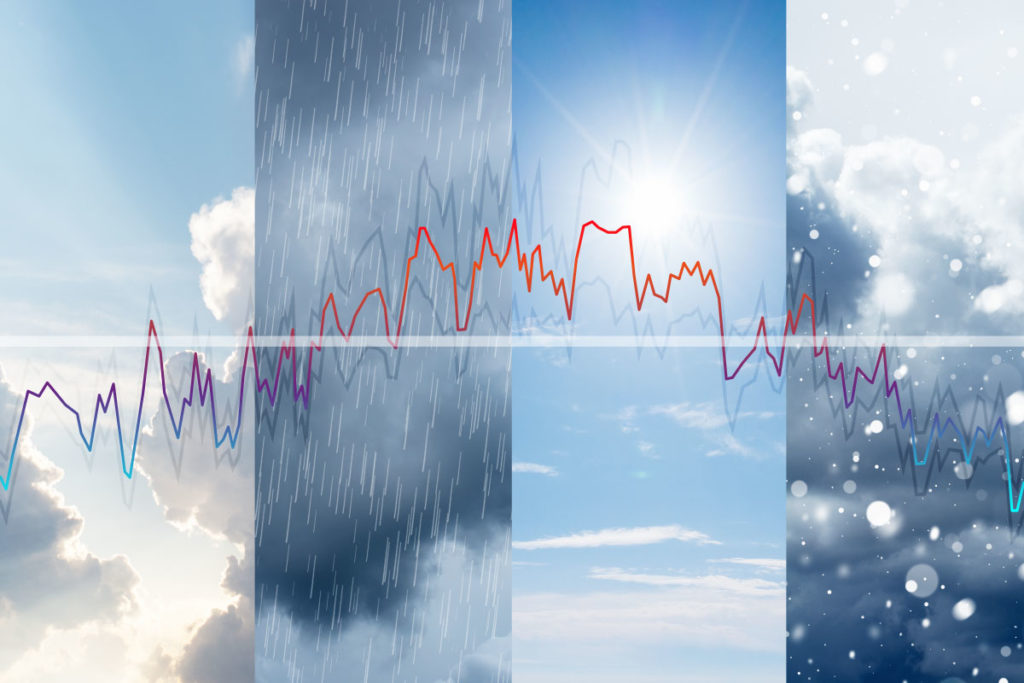
The growing season is the period during which plants grow, flower and produce fruit. The beginning of the growing season is characterized by at least six consecutive days of an average air temperature of at least 5°C. A lengthening of the growing season is expected in the near future and will continue significantly in the distant future. A change in vegetation phases has a significant impact on natural systems.
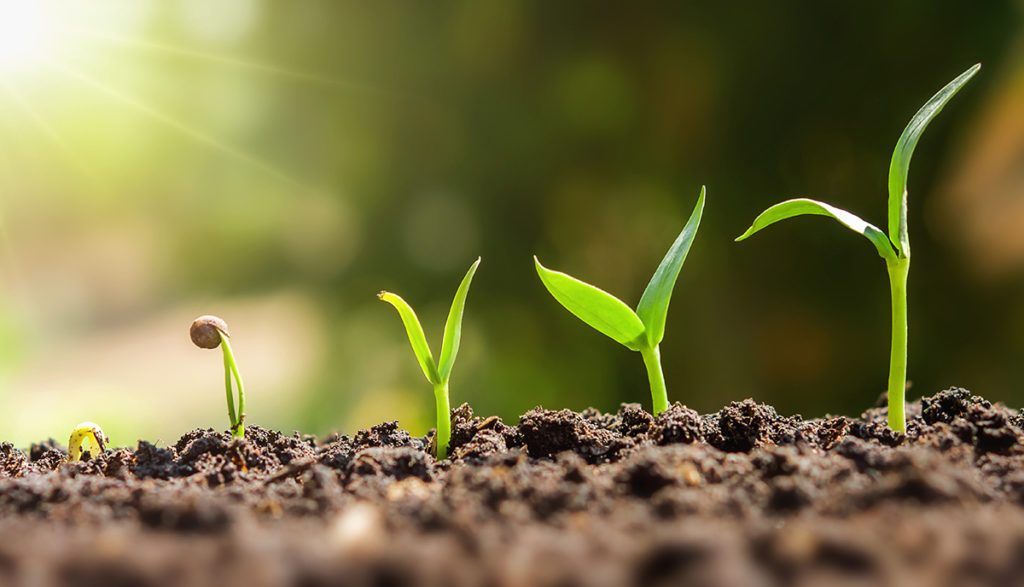
The precipitation that falls in the months of December, January and February is called winter precipitation. In the course of climate change, an increase in winter precipitation is expected. The parameter is given in millimetres (mm). The risk and frequency of flooding is increasing.
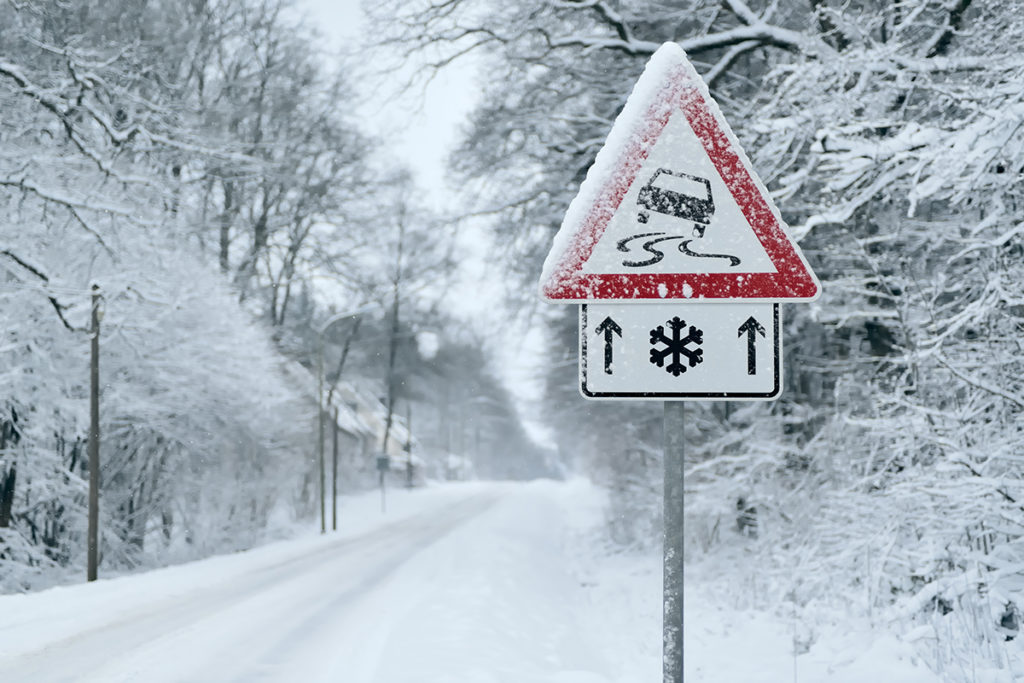
The precipitation that falls in the months of June, July and August is called summer precipitation. In the course of climate change, a decrease in summer precipitation is expected. The parameter is given in millimetres (mm). Summer precipitation increases the risk of droughts and low water.

In the long term, the changes in the regional water balance as a result of climate change will be reflected in impacts on groundwater levels, river discharge regimes and changes in water quality, but also in the more frequent occurrence of extreme events (e.g. floods, heavy rainfall, droughts). Water availability is also coming under greater scrutiny as a result of the low precipitation years 2018, 2019 and 2020, especially where it relies on punctual water withdrawals, e.g. from spring discharges.
Impacts
- Water demand increases due to longer growing seasons and more frequent dry spells
Initiatives
- Adjustment of water management if necessary increased irrigation demand e.g. in dry periods or for frost protection irrigation
The effects of climate change must also be taken into account in the area of civil protection. The focus here is on efforts to optimise or expand existing structures in emergency and rescue services as well as disaster management. The aim here is not only to react quickly and effectively in the event of extreme weather events (heat waves, floods, inundations, heavy rainfall events, storms) but also to prepare for disasters against the background of changing climatic conditions. The focus here is on both population protection and the protection of critical infrastructures.

